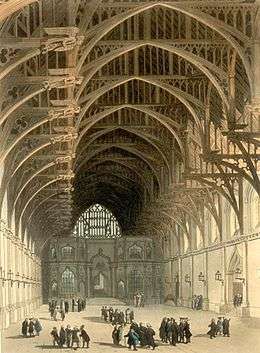List of castles in England

This list of castles in England is not a list of every building and site that has "castle" as part of its name, nor does it list only buildings that conform to a strict definition of a castle as a medieval fortified residence.[1] It is not a list of every castle ever built in England, many of which have vanished without trace, but is primarily a list of buildings and remains that have survived. In almost every case the buildings that survive are either ruined, or have been altered over the centuries. For several reasons, whether a given site is that of a medieval castle has not been taken to be a sufficient criterion for determining whether or not that site should be included in the list.
Castles that have vanished or whose remains are barely visible are not listed, except for some important or well-known buildings and sites. Fortifications from before the medieval period are not listed, nor are architectural follies. In other respects it is difficult to identify clear and consistent boundaries between two sets of buildings, comprising those that indisputably belong in a list of castles and those that do not. The criteria adopted for inclusion in the list include such factors as: how much survives from the medieval period; how strongly fortified the building was; how castle-like the surviving building is; whether the building has been given the title of "castle"; how certain it is that a medieval castle stood on the site, or that the surviving remains are those of a medieval castle; how well-known or interesting the building is; and whether including or excluding a building helps make the list, in some measure, more consistent.
In order to establish a list that is as far as possible comprehensive as well as consistent, it is necessary to establish its boundaries. Before the list itself, a discussion of its scope includes lengthy lists of buildings excluded from the main lists for various reasons. The Castellarium Anglicanum, an authoritative index of castles in England and Wales published in 1983, lists over 1,500 castle sites in England.[2] Many of these castles have vanished or left almost no trace. The present list includes more than 800 medieval castles of which there are visible remains, with over 300 having substantial surviving stone or brick remains.
History

A castle is a type of fortified structure, developed in Europe during the Middle Ages. The first castles appeared in France in the 10th century,[3] and in England during the 11th century. A few castles are known to have been built in England before the Normans invaded in 1066;[4] a great many were built in the years following, the principal mechanism by means of which the Normans were able to consolidate their control over the country.[5] Whilst a few important castles, such as the White Tower in the Tower of London, were built of stone, most early castles were motte-and-bailey castles of earthwork and timber, which could be constructed quickly. Some were later rebuilt in stone,[6] but there are a great many castle sites in England where all that is visible today are traces of earthworks.[7]
Castles continued to be built in England for several hundred years, reaching a peak of military sophistication in the late 13th century.[8] The two principal elements in their construction were the great tower or keep, such as the White Tower, and the fortified enclosure, such as is provided by the outer wall of the Tower of London. During the 14th century, largely as a result of the decline of feudalism,[9] the construction of strong castles began to decline, in favour of more lightly fortified structures often described as fortified manor houses.[10] In the far north of England, where conditions remained unsettled, fortified buildings continued to be built as late as the 16th century, not only by the rich and powerful but by any with adequate means, as defence not against great armies, but against the notorious Border Reivers. Many took the form of the pele tower, a smaller, more modest version of the castle keep,[11] and many of these still survive, often incorporated in later buildings.

Castles differed from earlier fortifications in that they were generally private fortified residences. Typically, a castle was the residence of a feudal lord, providing the owner with a secure base from which to control his lands,[12] and also a symbol of wealth and power. Earlier fortified structures, such as the Saxon burh or the Iron Age hill fort, provided public or communal defences,[13] as did medieval town or city walls. The many Roman forts of which ruins survive in Britain differed in being wholly military in nature - they were camps or strongholds of the Roman army. The Romans also built town or city walls in England, which can still be seen, for instance at Silchester.
By the 16th century the role of fortifications had changed once more with the development of artillery capable of breaching even thick stone walls. In the reign of Henry VIII, fears of invasion[14] led to the building of a series of new fortresses along the south coast of England,[15] known as the Device Forts or Henrician Castles. These were designed to use and to defend against artillery, and since they were not private residences, but national fortifications, they do not possess what architectural historians have come to see as the defining characteristics of a castle.[16] Nonetheless they are visibly castle-like, being compact, with battlemented walls, squat turrets and sometimes a keep; and they were the last generation of fortresses in England to be known as castles, long before architectural historians began to argue that they should not be.[17] One of them, Pendennis Castle, was one of the last Royalist strongholds to fall to the Parliamentarians during the English Civil War—starvation forcing surrender after a siege of five months.[18]
As the role of the castle as fortress declined in the later medieval period, its role as a residence increasingly became the more important. Castles such as Herstmonceux were built with fortifications seemingly designed more for show than for strength,[19] implying a further evolution in the role and concept of the castle, becoming less a means of enforcing power but instead a symbol of its possession, a castle becoming a grand residence proclaiming the status of its owner. Once fortifications had become altogether redundant, it became increasingly rare in England for new buildings to be described as castles, in contrast to France, where country houses continued to be known as châteaux.
Once no longer needed as fortresses, castles — if they were not abandoned — were, over the centuries, adapted and modernised to make them more suitable for continued use as residences:[20] large windows were inserted in defensive walls, as at Lumley; outer walls were demolished or lowered to open up views from within, as at Raby; new residential ranges were built to improve and extend accommodation, as at Windsor. Some castles were restored after falling into ruin, like Bamburgh;[21] others, like Belvoir, were demolished and rebuilt, retaining little or none of the original structure.[22] In the 18th and 19th centuries especially, many castles underwent "improvements" by architects such as Anthony Salvin, and in this period a fashion developed for entirely new houses to be built in the style of castles, and to be known as castles.[23][24] Amongst these was Peckforton Castle, built by Salvin: a building so authentic in its recreation of a medieval castle that it has been described as possibly the last serious fortified home built in Britain.[25]

Scope and exclusions
No list of castles in England is ever likely to be complete, because there will never be complete agreement in every case as to whether the remains of a building are those of a castle, whether a given place is the site of a castle, or whether a surviving building should be considered to be a castle.[26]
Perhaps because the castle has become the most familiar type of fortification, many sites of fortifications earlier than the 10th century have become known as castles. Most of these are Iron Age hill forts. Amongst the best known are Abbotsbury Castle, Barbury Castle, Bratton Castle, Cadbury Castle, Castle Dore, Chûn Castle, Liddington Castle, Maen Castle, Maiden Castle and Uffington Castle,[27] whilst many more appear in the List of hill forts in England. Others, such as Melandra Castle, Reculver Castle, Richborough Castle and Whitley Castle, are Roman forts, whilst Daw's Castle is a Saxon burh.[27] None of these is included in the present list unless it is also the site of a medieval castle, as is the case with, for instance, Portchester Castle, where an imposing castle was built within the surviving walls of the Roman fort.[28]

Nor are all medieval fortified sites included in the present list. The remains of town and city walls are excluded — most of these appear in the List of town walls in England and Wales. Also excluded are churches with defensive towers, such as Ancroft, Burgh by Sands, Edlingham, Garway, Great Salkeld and Newton Arlosh, as well as other fortified ecclesiastical sites such as Alnwick Abbey, Battle Abbey, Thornton Abbey, Wetheral Priory, Whalley Abbey and St Mary's Abbey, York.[29] Some of the pele towers of Northern England are included, but the more modest fortified buildings known as bastles are not, though the distinction between them is not always altogether clear. Amongst fortified manor houses, those given the title of castle are included, whilst many others were more lightly fortified and are excluded. Amongst these are Baddesley Clinton, Cowdray House, Farnhill Hall, Hipswell Hall, Ightham Mote, Little Wenham Hall, Markenfield Hall and Walburn Hall.[29]
The list includes pele towers that became known as castles, or preserve a castle-like aspect. Many others, or their remains, survive much altered—incorporated in later country houses or farmhouses, and are excluded. Amongst these are: Aske Hall, Biddlestone RC Chapel, Bolling Hall, Bolton Old Hall, Boltongate Rectory, Causey Park House, Clennell Hall, Cliburn Hall, Corbridge Low Hall, Cowmire Hall, Craster Arms (Beadnell), Croglin Old Pele, Denton Hall, Dovenby Hall, Dunstan Hall, East Shaftoe Hall, Godmond Hall, Great Salkeld Rectory, Hardrigg Hall, Hepscott Hall, Hetton Hall, Hollin Hall, Hutton Hall (Penrith), Irton Hall, Johnby Hall, Killington Hall, Kirkoswald College, Levens Hall, Little Harle Tower, Nether Hall, Netherby Hall, Ormside Hall, Pockerley Pele, Preston Patrick Hall, Randalholme Hall, Rock Hall, Rudchester Hall, Sella Park, Selside Hall, Skelsmergh Hall, Smardale Hall, Thistlewood Farmhouse, Warnell Hall, Weetwood Hall and Witton Tower.[29]
In the post-medieval period, the distinction between true castles and later mock castles is blurred by the extent to which medieval castles were adapted and rebuilt. At Greystoke a new castle was built incorporating a medieval pele tower;[30] at Thurland a new castle was built from the ruins of the old;[31] at Belvoir the old castle was demolished and a new one built.[22] The building of mock castles might be seen as the logical conclusion of a process already apparent in castles such as Herstmonceux or Tattershall, where the castle-like aspect of the building was becoming more for show than for strength.[19]

Amongst post-medieval buildings in England that are known as castles, a few, such as Peckforton Castle, closely resemble medieval castles. Many others, such as Clearwell Castle, have some castle-like features, and some, like Mereworth Castle, bear no resemblance whatsoever to a castle. The list excludes buildings that neither look like castles, nor incorporate the remains of castles. Amongst these are Bolebroke Castle, Bovey Castle, Bruce Castle, Castle Ashby, Castle Howard, Clifton Castle, Highclere Castle, Mereworth Castle, New Wardour Castle, Sherborne Castle, Wentworth Castle, and Wisbech Castle.[32] Many other buildings with some castle-like features are also excluded. Amongst these are Acton Castle, Allerton Castle, Augill Castle, Avon Castle, Bell's Castle, Bolesworth Castle, Bude Castle, Castle Eden Castle, Castle Goring, Cave Castle, Clearwell Castle, Cliffe Castle, Coates Castle, Creech Castle, Droskyn Castle, Edmond Castle, Enmore Castle, Ewell Castle, Farleigh Castle, Farley Castle, Fillingham Castle, Hatherop Castle, Headingley Castle, Highcliffe Castle, Hilfield Castle, Kenwith Castle, Kirby Knowle Castle, Knepp Castle, Luscombe Castle, Midford Castle, Mulgrave Castle, Otterburn Tower, Pentillie Castle, Reeve Castle, Ryde Castle, St. Clare Castle, Sibdon Castle, Sneaton Castle, Stanhope Castle, Studley Castle, Swinton Castle, The Citadel (Weston-under-Redcastle), Tregenna Castle, Vanbrugh Castle, Wadhurst Castle, Wattisham Castle, Whitehaven Castle, Whitstable Castle, Willersley Castle, and Willsbridge Castle.[32] Amongst those that have been demolished is Steephill Castle.
Artificial ruins and follies, often built as memorials or landscape features, are also excluded. Amongst these are Appley Tower, Black Castle, Bladon Castle, Blaise Castle, Bollitree Castle, Boston Castle, Braylsham Castle, Broadway Tower, Carr Hall Castle, Castlebourne, Clent Castle, Clopton Tower, Dinton Castle, Doyden Castle, Dunstall Castle, Durlston Castle, Fort Putnam, Hadlow Castle, Castle in Hagley Park Lawrence Castle, Long's Park Castle, Mow Cop Castle, Mowbray Castle, Pirton Castle, Radford Castle, Radway Tower, Ragged Castle (Badminton), Rivington Castle, Rodborough Fort, Ross Castle, Rothley Castle, Roundhay Castle, Sebergham Castle, Severndroog Castle, Shaldon Castle, Sham Castle (Bath), Sledmere Castle, Speedwell Castle, Stainborough Castle, Starlight Castle, Stowe Castle, Strattenborough Castle, Sundorne Castle, Toll House (Clevedon) and Wyke Castle.[32] Finally, the 16th-century Henrician Castles, whose design was closely inspired by medieval castles, are included, but later military fortifications—with just a few exceptions—are not.

However carefully the criteria for including a building or site on this list are set out, borderline cases are inevitable. Many buildings known to incorporate northern pele towers in their fabric, but are no longer castle-like—such as the Red Lion Tower in Haltwhistle—have been excluded. On the other hand, Corby Castle, in which a pele tower survives wholly encased in a later building,[33] is included because it is known as a castle, and by implication continued to fulfil the role of one, at least in part. Kimbolton Castle is included as the site of a medieval castle, and because the present mansion has a castellated aspect in deference to the medieval castle it replaced.
Key
| Key | |
|---|---|
| Accessible open space | |
| Castle open to the public | |
| English Heritage | |
| Historic House open to the public | |
| Museum | |
| National Trust | |
| NGS | Private, grounds open under the National Gardens Scheme |
| Name | Usually the name of the surviving building, but not always—for instance the remains of the historic Bampton Castle were incorporated in a later building known as Ham Court |
| Type | Usually the type of castle represented by the predominant surviving fortified remains |
| Date | Usually the dates of the principal building works relating to the surviving remains |
| Condition | An indication as to what remains of the original castle structure |
| Image | The building or site as it currently exists |
| Ownership / Access |
Brief information relating to the current ownership or use of the site, an icon signifying that the site is frequently open to the public |
Bedfordshire
Castles of which only earthworks, fragments or nothing remains include:[2]
- Bedford Castle†;
- Biggleswade Castle
- Bletsoe Castle
- Cainhoe Castle
- Chalgrave Castle
- Eastcotts Castle
- Etonbury Castle
- Flitwick Castle
- Higham Gobion Castle
- Odell Castle
- Old Warden Castle
- Podington Castle
- Renhold Castle
- Risinghoe Castle
- Thurleigh Castle
- Tilsworth Castle
- Toddington Castle
- Totternhoe Castle
- Yielden Castle
† Bedford Castle was demolished after a well-documented eight-week siege by Henry III, with around 2000 men, in 1224.[34]
| Name | Type | Date | Condition | Image | Ownership / Access | Notes |
|---|---|---|---|---|---|---|
| Someries Castle | Fortified manor house | 15th century | Fragmentary remains |  |
Brick, unfinished, ruined gatehouse and chapel survive.[35] |
Berkshire
Castles of which only earthworks, fragments or nothing remains include:[2]
| Name | Type | Date | Condition | Image | Ownership / Access | Notes |
|---|---|---|---|---|---|---|
| Donnington Castle | Castle | c. 1386 | Fragment |  |
Built by Richard Abberbury the Elder, destroyed during the English Civil War, gatehouse survives.[36] | |
| Windsor Castle | Keep and bailey | 12–19th century | Intact |  |
Royal palace | Restored and extended by James Wyatt and Jeffry Wyattville, 1800–30.[37] |
Bristol
Castles of which only vestiges remain include:[2]
Buckinghamshire
Castles of which only earthworks, fragments or nothing remains include:[2]
| Name | Type | Date | Condition | Image | Ownership / Access | Notes |
|---|---|---|---|---|---|---|
| Boarstall Tower | Fortified manor house | c. 1312 | Fragment |  |
Moated site, gatehouse survives, altered in the 16–17th centuries, converted to house 20th century.[38] |
Cambridgeshire
Castles of which only earthworks, fragments or nothing remains include:[2]
| Name | Type | Date | Condition | Image | Ownership / Access | Notes |
|---|---|---|---|---|---|---|
| Buckden Palace | Fortified manor house | 13–15th century | Fragment |  |
Claretian conference centre | Renamed Buckden Towers, partly demolished and remnants incorporated with a 19th-century house.[39] |
| Elton Hall | Fortified manor house | c. 1477 | Fragment |  |
Gatehouse survives, incorporated in building of 1662–1689, remodelled and extended in the 18–19th centuries.[40] | |
| Kimbolton Castle | Castellated house | 17–18th century | Intact | School | Site of medieval castle, rebuilt and later remodelled by Sir John Vanbrugh 1707–10.[41] | |
| Kirtling Tower | Fortified manor house | c. 1530 | Fragment |  |
NGS | 16th-century gatehouse on supposed site of moated Saxon castle.[42] |
| Longthorpe Tower | Tower house | 1263–1300 | Intact |  |
Elaborate scheme of domestic medieval wall paintings.[43] | |
| Northborough Castle | Fortified manor house | 1330–40 | Fragment |  |
Private | Gatehouse and hall survive, with 16/17th-century alterations.[44] |
| Woodcroft Castle | Quadrangular castle | c. 1280 | Habitable fragment |  |
Private | West range of original building survives, with alterations.[45] |
Cheshire
Castles of which only earthworks, fragments or nothing remains include:[2]
| Name | Type | Date | Condition | Image | Ownership / Access | Notes |
|---|---|---|---|---|---|---|
| Beeston Castle | Enclosure castle | 13–14th century | Ruins |  |
Sited on crag high above Cheshire Plain, 19th-century outer gatehouse.[46] | |
| Chester Castle | Keep and bailey | 12th century | Fragment |  |
Agricola tower sole feature of medieval castle to survive an 18th-century fire.[47] | |
| Cholmondeley Castle | Neo-romantic castle | 1801–19 | Intact |  |
Marquess of Cholmondeley |
Transformed into castle by Smirke, 1817–19.[48] |
| Doddington Castle | Tower house | c. 1403 | Substantially intact |  |
Private | Also known as Delves Hall. Building At Risk.[49] |
| Halton Castle | Castle | 13th century | Fragmentary remains |  |
Duchy of Lancaster |
Commanding position, 13th-century tower, 18th-century courthouse, folly of c. 1800.[50] |
| Peckforton Castle | Neo-romantic castle | 1844–50 | Intact |  |
Hotel | By Anthony Salvin, possibly the last serious fortified home built in Britain.[25] |
County Durham
Castles of which only earthworks or vestiges remain include:[2]
| Name | Type | Date | Condition | Image | Ownership / Access | Notes |
|---|---|---|---|---|---|---|
| Auckland Castle | Keep and bailey | 12–16th century | Rebuilt |  |
Church of England |
Mostly 16th-century, fragments remain of medieval castle, residence of the Bishop of Durham.[51] |
| Barnard Castle | Keep and bailey | 11–14th century | Ruins |  |
[52] | |
| Bowes Castle | Keep | 12th century | Fragmentary remains |  |
Ruins of keep survive.[53] | |
| Brancepeth Castle | Keep and bailey | 14–19th century | Reconstructed |  |
Private | Substantial medieval portions, including 5 towers incorporated in 19th-century rebuilding.[54] |
| Durham Castle | Keep and bailey | 11–14th century | Rebuilt |  |
University College, Durham | Much altered during continuous occupation since c. 1072.[55] |
| Lambton Castle | Neo-romantic castle | c. 1820–8 | Intact |  |
Wedding venue / Earl of Durham | Later additions demolished following subsidence.[56] |
| Lumley Castle | Quadrangular castle | c. 1392 | Intact |  |
Hotel / Earl of Scarbrough | Altered c. 1580 and 1721.[57] |
| Mortham Tower | Fortified manor house | 14–16th century | Intact |  |
Private | 15th-century tower, formerly in Yorkshire.[58] |
| Raby Castle | Castle | 12–14th century | Intact |  |
Lord Barnard |
Altered in the 18–19th centuries.[59] |
| Raby Old Lodge | Tower house | 16th century | Restored | Holiday accommodation | Probably built as a hunting lodge for the Neville family of Raby Castle.[60] | |
| Scargill Castle | Tower house | 13–15th century | Fragment |  |
Private, farm | Amongst farm buildings.[61] |
| Walworth Castle | Sham castle | c. 1600 | Restored |  |
Hotel | South-west tower and adjoining wall possibly medieval.[62] |
| Witton Castle | Castle | c. 1410 | Restored |  |
Caravan site | Extended in 1790–95. Used as a leisure centre for a caravan site.[63] |
Cornwall
Castles of which little or nothing remains include:[2]
| Name | Type | Date | Condition | Image | Ownership / Access | Notes |
|---|---|---|---|---|---|---|
| Caerhays Castle | Neo-romantic castle | 1807–10 | Intact | 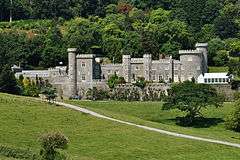 |
Built in 1808 by John Nash.[64] | |
| Carn Brea Castle | Sham castle | 15–19th century | Intact | 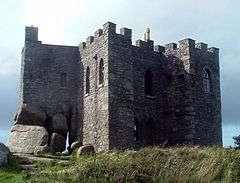 |
Restaurant | Possible medieval hunting lodge rebuilt in the 18–19th centuries.[65] |
| Ince Castle | Semi-fortified house | c. 1640 | Intact |  |
NGS | House may have been held against the Roundheads in 1646.[66] |
| Launceston Castle | Keep and bailey | 11–13th century | Ruins | [67] | ||
| Pendennis Castle | Artillery fort | 1540–98 | Intact |  |
Withstood 5-month siege in 1646.[18] | |
| Pengersick Castle | Fortified manor house | c. 1510 | Fragment |  |
4-storey tower remains, with later building.[68] | |
| Place House, Fowey | Tower house | 15–19th century | Rebuilt |  |
Private | Original tower house defended against the French in 1475, subsequently strengthened, later rebuilt.[69] |
| Restormel Castle | Shell keep | 12–13th century | Ruins | [70] | ||
| St Catherine's Castle | Artillery fort | 1538–40 | Ruins |  |
At mouth of River Fowey.[71] | |
| St. Mawes Castle | Artillery fort | 1540–3 | Intact | Position not defensible from land attack.[72] | ||
| St. Michael's Mount | Fortified site | 12–17th century | Substantially intact |  |
Castle and priory church comprise single building.[73] | |
| Tintagel Castle | Twin bailey | 1227–33 | Fragmentary remains |  |
[74] | |
| Trematon Castle | Shell keep | 12–13th century | Ruins |  |
Duchy of Cornwall | [75] |
Cumbria
Castles of which only earthworks, vestiges or no traces remain include:[2]
| Name | Type | Date | Condition | Image | Ownership / Access | Notes |
|---|---|---|---|---|---|---|
| Appleby Castle | Keep and bailey | 12–17th century | Restored |  |
Private | Restored in the 17th century by Lady Anne Clifford.[76] |
| Armathwaite Castle | Tower house | 15th century | Intact |  |
Private | Incorporated in later buildings.[77] |
| Arnside Tower | Tower house | 15th century | Ruins |  |
Private | Freestanding tower house.[78] |
| Askerton Castle | Castle | 14–16th century | Restored |  |
Private, farm | Altered by Anthony Salvin.[79] |
| Beetham Hall | Fortified manor house | 14th century | Partly ruined |  |
Private | [80] |
| Bewcastle Castle | Courtyard castle | 14–15th century | Fragmentary ruins |  |
Sited within Roman fort.[81] | |
| Bewley Castle | Fortified manor house | 13–14th century | Fragmentary ruins | Private | Once a residence of the Bishops of Carlisle.[82] | |
| Blencow Hall | Fortified house | 15–16th century | Intact |  |
Holiday accommodation | Altered in 1590.[83] |
| Brackenburgh Old Tower | Pele tower | 14–15th century | Substantially intact | Private | Adjoining large 19th-century house.[84] | |
| Brackenhill Tower | Tower house | 1586 | Intact | Holiday accommodation | Restored 21st century.[85] | |
| Branthwaite Hall | Pele tower | 14–15th century | Intact |  |
Private | 17th-century additions.[86] |
| Brough Castle | Keep and bailey | 11–14th century | Ruins |  |
Restored in 1659–62 by Lady Anne Clifford.[87] | |
| Brougham Castle | Keep and bailey | 13–14th century | Ruins |  |
Converted into country house in 17th century by Lady Anne Clifford.[88] | |
| Brougham Hall | Fortified manor house | 13–19th century | Ruins | 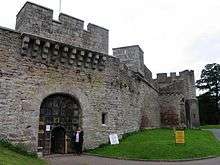 |
Crafts centre | Ruins of 19th-century house incorporating remains of earlier building.[89] |
| Broughton Tower | Pele tower | 14th century | Intact |  |
School | Incorporated in later building.[90] |
| Burneside Hall | Tower house | 14th century | Ruins | 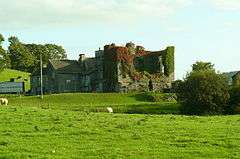 |
Private | [91] |
| Carlisle Castle | Keep and bailey | 12–15th century | Substantially intact |  |
Converted to barracks 19th century.[92] | |
| Catterlen Hall | Tower house | 15th century | Intact |  |
Private | Later additions.[93] |
| Clifton Hall | Pele tower | 16th century | Substantially intact |  |
Used as a farm building until 1973.[94] | |
| Cockermouth Castle | Enclosure castle | 13–14th century | Partly restored |  |
Private | 19th-century additions.[95] |
| Corby Castle | Tower house | 13th century | Rebuilt |  |
Private | Concealed within a Georgian Mansion House.[33] |
| Dacre Castle | Tower house | 14th century | Restored |  |
Private | Restored in the 17th and 19th centuries.[96] |
| Dalston Hall | Fortified house | 15th century | Intact |  |
Hotel | Later additions.[97] |
| Dalton Castle | Pele tower | 14th century | Restored |  |
Remodelled c. 1704 and 1856.[98] | |
| Drawdykes Castle | Tower house | 14th century | Intact | Private, farm | Original tower with early Classical Revival facade.[99] | |
| Drumburgh Castle | Tower house | 14th century | Habitable |  |
Private | Converted into farmhouse.[100] |
| Gleaston Castle | Enclosure castle | 14th century | Fragmentary remains |  |
Private | Abandoned late 15th century.[101] |
| Greystoke Castle | Castle | 14–19th century | Rebuilt |  |
Wedding venue | Rebuilt incorporating parts of 14th-century building, remodelled in 1840 by Anthony Salvin.[102] |
| Harbybrow Tower | Pele tower | 15th century | Ruin | Private | Adjoining 19th-century farmhouse.[103] | |
| Hayton Castle | Tower house | 14–15th century | Substantially intact | Private | Castle converted to house.[104] | |
| Hazelslack Tower | Pele tower | 14th century | Ruins |  |
Private | Near Arnside.[105] |
| Howgill Castle | Tower house | 14th century | Substantially intact | Private | Altered and remodelled in the 17–18th century.[106] | |
| Hutton-in-the-Forest | Pele tower | 14–19th century | Intact |  |
Large country-house extensions.[107] | |
| Hutton John | Pele tower | 14th century | Intact |  |
Later alterations and additions.[108] | |
| Ingmire Hall | Pele tower | 16–20th century | Rebuilt |  |
Private apartments | Incorporated in large, mostly 19th-century mansion.[109] |
| Isel Hall | Tower house | 14–15th century | Intact |  |
Later additions.[110] | |
| Kendal Castle | Ringwork | 12–14th century | Fragmentary remains |  |
[111] | |
| Kentmere Hall | Pele tower | 14th century | Intact |  |
Private | [112] |
| Kirkandrews Tower | Pele tower | 16th century | Intact |  |
Private | [113] |
| Linstock Castle | Tower house | 12–13th century | Substantially intact | Private | Altered and remodelled in the 17–20th century.[114] | |
| Lowther Castle | Neo-romantic castle | 1806–14 | Ruins |  |
Shell of a 19th-century castle by Smirke, on site of medieval hall.[115] | |
| Middleton Hall | Fortified manor house | 14th century | Habitable |  |
Private | Altered and extended in the 15–19th centuries.[116] |
| Millom Castle | Castle | 14th century | Ruins |  |
16–17th-century farmhouse built into ruins.[117] | |
| Muncaster Castle | Tower house | 13–14th century | Restored |  |
Remodelled by Anthony Salvin, home of Tom Fool, 16th-century jester.[118] | |
| Naworth Castle | Keep and bailey | 13–16th century | Restored | Wedding venue Earl of Carlisle |
Altered and restored in the 18th and 19th centuries.[119] | |
| Newbiggin Hall | Fortified house | 15–16th century | Intact |  |
Private | Remodelled by Anthony Salvin.[120] |
| Pendragon Castle | Tower house | 12–14th century | Fragmentary remains |  |
[121] | |
| Penrith Castle | Castle | 14–15th century | Fragmentary remains | [122] | ||
| Piel Castle | Castle | 14–15th century | Ruins |  |
Also known as Fouldrey Castle.[123] | |
| Prior's Tower, Carlisle | Pele tower | 15th century | Intact |  |
Church of England | Part of the Deanery, alongside later buildings.[124] |
| Rose Castle | Quadrangular Castle | 15–16th century | Restored |  |
Church of England | Converted to private house 17th century, residence of the Bishop of Carlisle until 2011.[125] |
| Scaleby Castle | Tower house | 13–15th century | Partly ruined |  |
Private | Incorporated with later house.[126] |
| Sizergh Castle | Tower house | 14–16th century | Restored |  |
Altered in the 18–20th centuries.[127] | |
| Toppin Castle | Sham castle | 19th century | Intact |  |
Private | Imitation tower house.[128] |
| Ubarrow Hall | Pele tower | Medieval | Substantially intact |  |
Private | Alongside later building, reduced in height.[129] |
| Wharton Hall | Fortified manor house | 14–17th century | Partly restored |  |
Private | [130] |
| Whitehall, Mealsgate | Tower house | 14–15th century | Substantially intact | Holiday accommodation | Alterations by Anthony Salvin.[131] | |
| Workington Hall | Tower house | 14–18th century | Ruins |  |
Local authority | Inhabited until 1929, requisitioned by the army in the Second World War and since allowed to fall into ruin. Also known as Curwen Hall.[132][133] |
| Wray Castle | Neo-romantic castle | 1840–7 | Intact |  |
[134] | |
| Wraysholme Tower | Tower house | 15th century | Substantially intact |  |
Private, farm | Used as barn and cow-house, adjoining a 19th-century house.[135] |
| Yanwath Hall | Pele tower | 15th century | Intact |  |
Private | Adjoining later building.[136] |
Derbyshire
Castles of which only earthworks, vestiges or no traces remain include:[2]
| Name | Type | Date | Condition | Image | Ownership / Access | Notes |
|---|---|---|---|---|---|---|
| Bolsover Castle | Castle | 12–17th century | Rebuilt |  |
Castle rebuilt as a 17th-century mansion.[137] | |
| Codnor Castle | Castle | 13–14th century | Fragmentary remains |  |
[138] | |
| Elvaston Castle | Castellated house | 17–19th century | Derelict |  |
Derbyshire County Council | Built in 1633, remodelled by James Wyatt in 19th century, now within country park. Building At Risk.[139] |
| Haddon Hall | Fortified manor house | 14–15th century | Intact |  |
Altered in the 16–17th centuries, restored in the 1920s.[140] | |
| Mackworth Castle | Fortified manor house | 15th century | Fragment |  |
Private | Ruined gatehouse adjoining farm.[141] |
| Peveril Castle | Keep and bailey | 11–14th century | Ruins | 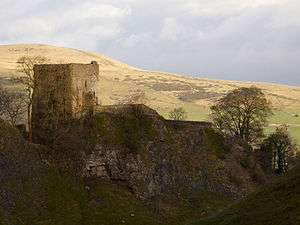 |
Commanding position above ravine.[142] | |
| Riber Castle | Sham castle | 1868 | Ruins |  |
Private | School 1892–1930.[143] |
| Wingfield Manor | Fortified manor house | 15th century | Ruins |  |
Abandoned in the 18th century.[144] |
Devon
Castles of which only earthworks remain include:[2]
| Name | Type | Date | Condition | Image | Ownership / Access | Notes |
|---|---|---|---|---|---|---|
| Affeton Castle | Fortified manor house | 15th century | Fragment |  |
Private | Gatehouse of house sacked during English Civil War, with 19th-century alterations.[145] |
| Berry Pomeroy Castle | Enclosure castle | 15th century | Ruins |  |
Very late castle, designed to defend against artillery.[146] | |
| Bickleigh Castle | Fortified manor house | 15th century | Restored | 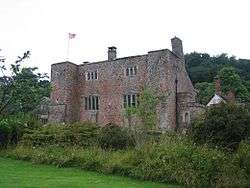 |
Wedding venue | Incorporated in later buildings.[147] |
| Compton Castle | Fortified manor house | 14–16th century | Restored | 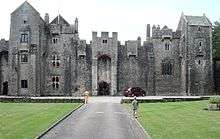 |
Used as farm after 1750, restored 20th century.[148] | |
| Dartmouth Castle | Castle | 1481 | Restored |  |
Converted to artillery castle 1509–47.[149] | |
| Castle Drogo | Neo-romantic castle | 1911–1930 | Intact | 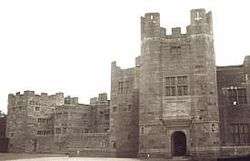 |
By Edwin Lutyens.[150] | |
| Gidleigh Castle | Keep | c. 1300 | Ruins |  |
[151] | |
| Hemyock Castle | Enclosure castle | c. 1380 | Fragmentary remains |  |
Private | [152] |
| Kingswear Castle | Artillery fort | 1491–1502 | Intact |  |
Landmark Trust | [153] |
| Lydford Castle | Keep and bailey | 12–13th century | Ruins |  |
[154] | |
| Marisco Castle | Keep and bailey | c. 1243 | Restored |  |
Restored in 1643.[155] | |
| Okehampton Castle | Keep and bailey | 11–14th century | Fragmentary remains |  |
[156] | |
| Plympton Castle | Motte and bailey | 12th century | Fragmentary remains |  |
[157] | |
| Powderham Castle | Fortified manor house | 14–16th century | Restored |  |
Earl of Devon |
Remodelled in the 18th and 19th centuries.[158] |
| Rougemont Castle (Exeter) | Castle | 11–12th century | Fragments |  |
Wedding venue | Medieval fragments survive with later buildings.[159] |
| Salcombe Castle | Artillery fort | 1540s | Ruins | Refortified in 1643–45.[160] | ||
| Tiverton Castle | Quadrangular castle | 14th century | Partly habitable |  |
16th-century house built within the castle.[161] | |
| Totnes Castle | Shell keep | 11–14th century | Ruins | Well-preserved keep on high motte.[162] | ||
| Watermouth Castle | Neo-romantic castle | 1825–45 | Intact | 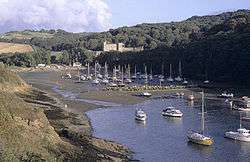 |
Theme park | [163] |
Dorset
Castles of which only earthworks, fragments or nothing remains include:[2]
| Name | Type | Date | Condition | Image | Ownership / Access | Notes |
|---|---|---|---|---|---|---|
| Brownsea Castle | Castellated house | 16–19th century | Intact |  |
Incorporates part of a 16th-century Henrician Castle.[164] | |
| Christchurch Castle | Motte and bailey | 12–14th century | Fragmentary remains | Hall house known as Constable's House survives, with rare Norman chimney.[165] | ||
| Corfe Castle | Keep and bailey | 11–13th century | Extensive ruins |  |
Besieged and slighted during the English Civil War.[166] | |
| Lulworth Castle | Sham castle | c. 1610 | Restored | .jpg) |
Hunting lodge, gutted by fire 1929.[167] | |
| Pennsylvania Castle | Neo-romantic castle | 1800 | Intact |  |
Private | On the Isle of Portland, built for John Penn to designs by James Wyatt.[168] |
| Portland Castle | Artillery fort | 1539 | Intact | Private residence 1816–70.[169] | ||
| Rufus Castle | Castle | 15th century | Ruins |  |
Private | Also known as Bow and Arrow Castle.[170] |
| Sherborne Old Castle | Keep and bailey | 12th century | Ruins |  |
Replaced by 16–17th century house, which became known as Sherborne Castle.[171] | |
| Woodsford Castle | Fortified manor house | 14th century | Habitable |  |
Landmark Trust | [172] |
East Riding of Yorkshire
Castles of which only earthworks, fragments or nothing remains include:[2]
| Name | Type | Date | Condition | Image | Ownership / Access | Notes |
|---|---|---|---|---|---|---|
| Paull Holme Tower | Tower House | 15th century | Ruins |  |
Private | Originally part of larger house, roofless.[173] |
| Skipsea Castle | Motte and Bailey | 11th century | Earthworks |  |
Well-preserved earthworks.[174] | |
| Wressle Castle | Quadrangular castle | 1390 | Ruins |  |
Private, farm | South range remains, inhabited until gutted by fire in 1796.[175] |
East Sussex
Castles of which little or nothing remains include:[2]
| Name | Type | Date | Condition | Image | Ownership / Access | Notes |
|---|---|---|---|---|---|---|
| Bodiam Castle | Quadrangular castle | c. 1385 | Ruins | 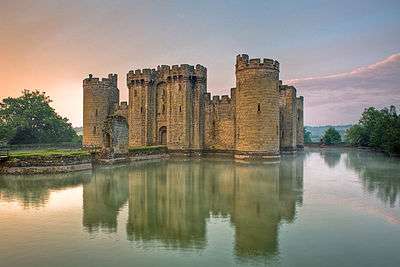 |
Wide moat.[176] | |
| Camber Castle | Artillery fort | c. 1540 | Ruins |  |
"Dismantled" 1642 after sea receded.[177] | |
| Hastings Castle | Keep and bailey | 12th century | Fragmentary ruins |  |
Local Authority |
Ruined by 1399.[178] |
| Herstmonceux Castle | Fortified mansion | 15th century | Restored | Queen's University | Brick, interior dismantled in 1777, restored 20th century, former home of Royal Greenwich Observatory, now Study Centre.[179] | |
| Lewes Castle | Keep and bailey | 12–14th century | Ruins | Unusual in having two mottes[180] | ||
| Pevensey Castle | Keep and bailey | 12th century | Ruins |  |
Castle built within surviving walls of Roman fort of Saxon Shore.[181] | |
| Rye Castle (Ypres Tower) | Tower House | c. 1250 | Intact |  |
Originally called Baddings Tower.[182] |
Essex
Castles of which only earthworks remain include:[2]
† Pleshey Castle is a good example of a motte-and-bailey castle: only earthworks and a medieval brick bridge remain.[183]
| Name | Type | Date | Condition | Image | Ownership / Access | Notes |
|---|---|---|---|---|---|---|
| Colchester Castle | Tower keep | 11th century | Intact |  |
Local authority |
Reduced in height in 17th century.[184] |
| Hadleigh Castle | Castle | 13–14th century | Fragmentary remains |  |
[185] | |
| Hedingham Castle | Tower keep | 1130–40 | Substantially intact |  |
Castle demolished in the 17th century except for keep, well-preserved interior despite fire of 1954.[186] | |
| Walden Castle | Keep and bailey | 12th century | Fragmentary remains |  |
Remains of keep.[187] |
Gloucestershire
Castles of which only earthworks, fragments or nothing remains include:[2]
- Bledisloe Tump
- Brimpsfield Castle
- Castle Hale (Painswick)
- Castle Tump (Dymock)
- Cirencester Castle
- English Bicknor Castle
- Gloucester Castle
- Hailes Castle (Stanway)
- Haresfield Mount
- Hewelsfield Motte
- Holme Castle (Tewkesbury)
- Little Camp Hill (Lydney)
- Littledean Camp
- Miserden Castle
- Newington Bagpath Motte
- Newnham on Severn Castle
- Ruardean Castle
- South Cerney Castle
- Stow Green (St. Briavels)
- Taynton Castle
- Weston Park (Saintbury)
- Winchcombe Castle
| Name | Type | Date | Condition | Image | Ownership / Access | Notes |
|---|---|---|---|---|---|---|
| Berkeley Castle | Keep and bailey | 12–14th century | Intact |  |
Largely unaltered until the 1920s, when interior modernised by 8th Earl of Berkeley.[188] | |
| Beverstone Castle | Pentagonal castle | 13–15th century | Ruins |  |
NGS | 17th-century house built within ruins.[189] |
| St. Briavel's Castle | Keep and bailey | 13th century | Habitable |  |
Youth hostel.[190] | |
| Sudeley Castle | Quadrangular castle | 15th century | Restored |  |
Restored as a country house in the 19th century.[191] | |
| Thornbury Castle | Fortified house | c. 1511 | Substantially intact |  |
Hotel | Restored in the 19th century.[192] |
Greater London
Castles of which no traces remain include:[2]
| Name | Type | Date | Condition | Image | Ownership / Access | Notes |
|---|---|---|---|---|---|---|
| Tower of London | Concentric castle | 11–13th century | Intact |  |
Historic Royal Palaces | White Tower built c. 1077–1100, curtain walls added in the 13th century, working portcullis.[193] |
Greater Manchester
Castles of which only earthworks, fragments or nothing remains include:[2]
| Name | Type | Date | Condition | Image | Ownership / Access | Notes |
|---|---|---|---|---|---|---|
| Radcliffe Tower | Tower house | 1403 | Fragment | 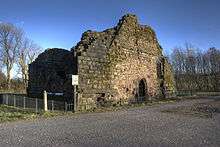 |
Local authority |
Ruinous tower formerly incorporated in timber house.[194] |
Hampshire
Castles of which only earthworks or vestiges remain include:[2]
| Name | Type | Date | Condition | Image | Ownership / Access | Notes |
|---|---|---|---|---|---|---|
| Calshot Castle | Artillery fort | 16th century | Substantially intact | Altered in the 18–20th centuries, in use until 1961.[195] | ||
| Hurst Castle | Artillery fort | 16th century | Substantially intact |  |
Repaired and refortified in the 19th century.[196] | |
| Netley Castle | Artillery fort | 16–19th century | Rebuilt |  |
Convalescent home | Remodelled and extended in 1885–90.[197] |
| Odiham Castle | Shell keep and bailey | Early 13th century | Fragmentary ruins |  |
Local authority |
Built by King John.[198] |
| Portchester Castle | Keep and bailey | 11–12th century | Extensive ruins | 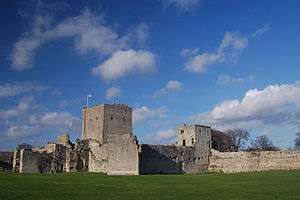 |
Built within surviving walls of Roman fort of the Saxon Shore.[28] | |
| Southampton Castle | Keep and bailey | 11–14th century | Fragments |  |
North bailey wall survives.[199] | |
| Southsea Castle | Artillery fort | 16th century | Rebuilt | Local authority |
Altered several times.[200] | |
| Winchester Castle | Motte and bailey | 11–13th century | Fragment | Local authority |
Great hall survives, reroofed in 1873.[201] | |
| Wolvesey Castle | Castle | 12th century | Ruins |  |
[202] |
Herefordshire
Castles of which little or no traces remain include:[2]
- Almeley Castle
- Ashton Castle
- Bredwardine Castle
- Bronsil Castle
- Colwall Castle
- Dorstone Castle
- Eardisland Castle
- Eardisley Castle
- Edvin Loach Castle
- Ewyas Harold Castle†;
- Hereford Castle
- Huntington Castle
- Kilpeck Castle
- Kingsland Castle
- Kington Castle
- Lingen Castle
- Lyonshall Castle
- Much Marcle Castle
- Newcourt Tump (Bacton)
- Newton Tump (Clifford)
- Orcop Castle
- Penyard Castle
- Pipe Aston Castle
- Richard's Castle
- Stapleton Castle
- Urishay Castle
- Wacton Castle
- Walford Castle
- Walterstone Castle
† Ewyas Harold Castle is recorded in the Domesday Book and was probably built c. 1048.[203]
| Name | Type | Date | Condition | Image | Ownership / Access | Notes |
|---|---|---|---|---|---|---|
| Brampton Bryan Castle | Castle | 13–14th century | Ruins |  |
Private | Gatehouse survives.[204] |
| Clifford Castle | Motte and bailey | 11–13th century | Fragments |  |
Private | Building At Risk.[205] |
| Croft Castle | Quadrangular castle | 14th century | Rebuilt |  |
Converted to a 16/17th-century house.[206] | |
| Downton Castle | Neo-romantic castle | c. 1774–78 | Intact |  |
Private | Altered and extended in 1860–70.[207] |
| Eastnor Castle | Neo-romantic castle | 1811–20 | Intact |  |
By Robert Smirke.[208] | |
| Goodrich Castle | Concentric castle | 12–13th century | Ruins | 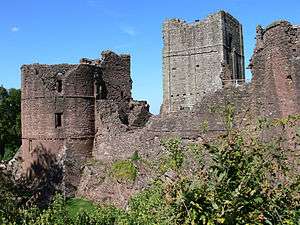 |
Partly demolished during English Civil War.[209] | |
| Hampton Court | Fortified manor house | 1427 | Intact |  |
Remodelled in 1830–40s.[210] | |
| Kentchurch Court | Fortified manor house | 14th century | Fragment | 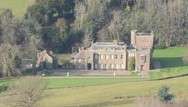 |
Medieval tower and gateway survive, remainder largely rebuilt by Nash 1795–1807.[211] | |
| Kinnersley Castle | Castle | Medieval | Rebuilt |  |
16–17th-century house on the site of a medieval castle.[212] | |
| Longtown Castle | Keep and bailey | 12–13th century | Fragmentary ruins |  |
Circular keep.[213] | |
| Pembridge Castle | Keep and bailey | 12–13th century | Partly habitable |  |
Private | Reconstructed 20th century.[214] |
| Snodhill Castle | Keep and bailey | 11–14th century | Fragmentary ruins |  |
[215] | |
| Treago Castle | Fortified manor house | 15–16th century | Restored |  |
Private | Altered in the 17–19th centuries.[216] |
| Wigmore Castle | Keep and bailey | 11–14th century | Fragmentary ruins |  |
Partly dismantled in 1643.[217] | |
| Wilton Castle | Castle | 13th century | Fragmentary ruins |  |
Remains incorporated in a 19th-century house.[218] |
Hertfordshire
Castles of which only earthworks, fragments or nothing remains include:[2]
| Name | Type | Date | Condition | Image | Ownership / Access | Notes |
|---|---|---|---|---|---|---|
| Berkhamsted Castle | Motte and bailey | 11–13th century | Fragmentary remains |  |
Double Moat.[219] Unoccupied since 1495.[220] | |
| Hertford Castle | Motte and bailey | 11–12th century | Fragments |  |
Local authority | 15th-century gatehouse survives, altered and extended in the 18–20th centuries.[221] |
Isle of Wight
Castles of which little or nothing remains include:[2]
| Name | Type | Date | Condition | Image | Ownership / Access | Notes |
|---|---|---|---|---|---|---|
| Carisbrooke Castle | Keep and bailey | 12–14th century | Substantially intact | 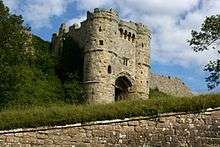 |
Refortified in the 1590s as artillery fortress, former seat of the Governor of the Isle of Wight.[222] | |
| Norris Castle | Neo-romantic castle | c. 1800 | Intact | 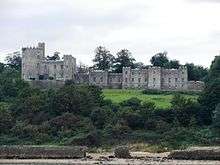 |
Private | Gothic Revival, by James Wyatt.[223] |
| Yarmouth Castle | Artillery fort | 1547 | Substantially intact | Altered in the 17th century.[224] | ||
| West Cowes Castle | Artillery fort | 16–19th century | Rebuilt |  |
Royal Yacht Squadron | Fragments of a 16th-century structure incorporated in a later building.[225] |
Isles of Scilly
Castles of which only vestiges remain include:[2]
| Name | Type | Date | Condition | Image | Ownership / Access | Notes |
|---|---|---|---|---|---|---|
| Cromwell's Castle | Artillery tower | 1651 | Substantially intact |  |
[226] | |
| Star Castle | Artillery fort | 1593 | Intact |  |
Hotel | Important and complete example of Elizabethan fort.[227] |
Kent
Castles of which little or nothing remains include:[2]
| Name | Type | Date | Condition | Image | Ownership / Access | Notes |
|---|---|---|---|---|---|---|
| Allington Castle | Fortified house | 13–14th century | Restored |  |
Wedding venue | Restored in 1905–1929.[228] |
| Canterbury Castle | Tower keep | 12th century | Ruins |  |
Local Authority |
Demolished in 1792.[229] |
| Chiddingstone Castle | Neo-romantic castle | 19th century | Intact |  |
17th-century building converted to a castle in the 19th century.[230] | |
| Chilham Castle | Keep and bailey | 11–14th century | Intact |  |
NGS | Keep survives with Jacobean house.[231] |
| Cooling Castle | Keep and bailey | 1380s | Part ruined |  |
Wedding venue | Well-preserved gatehouse survives, barns used for events.[232] |
| Deal Castle | Artillery fort | 16th century | Intact |  |
Formerly residence of Captain of the Cinque Ports.[233] | |
| Dover Castle | Concentric castle | 12–13th century | Intact | 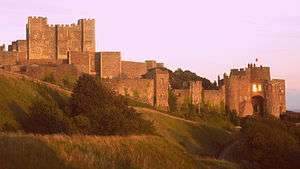 |
Adapted for modern warfare 18–19th centuries.[234] | |
| Eynsford Castle | Castle | 12th century | Fragmentary ruins |  |
[235] | |
| Hever Castle | Fortified manor house | 14th century | Restored | Restored early 19th century, working portcullis.[236] | ||
| Kingsgate Castle | Neo-romantic castle | 18–19th century | Intact |  |
Private apartments | Built c. 1760, rebuilt late 19th century.[237] |
| Leeds Castle | Castle | 12–15th century | Restored |  |
Extensively rebuilt in 1822 and 1926.[238] | |
| Leybourne Castle | Castle | 13th century | Fragmentary ruins |  |
Private | 16th-century house partly incorporating ruins, rebuilt in 1931.[239] |
| Lullingstone Castle | Semi-fortified house | 1543–80 | Fragment |  |
16th-century gatehouse incorporated into a later house.[240] | |
| Lympne Castle | Fortified house | 13–14th century | Restored |  |
Wedding venue | Restored and extended in 1907–12.[241] |
| Otford Palace | Fortified manor house | 16th century | Ruins |  |
Local Authority |
The palace was one of the chain of houses belonging to the archbishops of Canterbury.[242] |
| Penshurst Place | Fortified manor house | 14–15th century | Fragment |  |
Remodelled in the 19th century, single tower and stretch of wall survive from fortifications of c. 1400.[243] | |
| Rochester Castle | Tower keep | 1127 | Ruins |  |
Keep 125 ft (38 m) high to top of turrets.[244][245] | |
| St Leonard's Tower, West Malling | Tower keep | 1080 | Ruins |  |
[246] | |
| Saltwood Castle | Castle | 12–14th century | Part restored | Private | [247] | |
| Sandgate Castle | Artillery fort | 1539–40 | Substantially intact |  |
Private | Altered in 1805–06.[248] |
| Scotney Castle | Fortified manor house | 1378–80 | Fragment |  |
Single surviving tower incorporated in later house.[249] | |
| Sissinghurst Castle | Fortified manor house | 15th century | Rebuilt | No fortifications remaining.[250] | ||
| Starkey Castle | Manor house | 14th century | Fragment |  |
Private | Fine medieval hall-house remains from possibly fortified manor house.[251] |
| Stone Castle | Tower | 12th century | Intact | 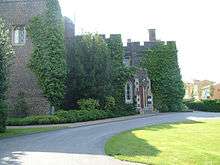 |
Wedding venue | Medieval tower incorporated in building of 1825.[252] |
| Sutton Valence Castle | Keep and bailey | 12th century | Fragmentary remains |  |
[253] | |
| Tonbridge Castle | Keep and bailey | 11–13th century | Fragment | Local authority |
Gatehouse survives.[254] | |
| Upnor Castle | Artillery fort | 1559–67, 1599–1601 | Substantially intact |  |
[255] | |
| Walmer Castle | Artillery fort | 1539 | Intact |  |
Residence of the Lord Warden of the Cinque Ports from 18th century.[256] | |
| Westenhanger Castle | Fortified manor house | c. 1343 | Fragment |  |
Wedding venue | 18th-century farmouse built within ruins.[257] |
Lancashire
Castles of which only earthworks or vestiges remain include:[2]
| Name | Type | Date | Condition | Image | Ownership / Access | Notes |
|---|---|---|---|---|---|---|
| Ashton Hall | Tower house | 14–19th century | Intact | 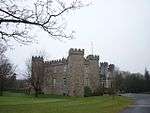 |
Lancaster Golf Club | Near Stodday, 14th-century tower incorporated into a later building.[258] |
| Borwick Hall | Pele tower | 14th century | Intact |  |
Outdoor education centre | Incorporated in mainly 16th-century building.[259] |
| Clitheroe Castle | Keep and bailey | 11–12th century | Ruins |  |
[260] | |
| Hornby Castle | Keep | 13th century | Fragment | .jpg) |
Private | Keep rebuilt early 16th century, incorporated into an 18–19th-century house.[261] |
| Lancaster Castle | Keep and bailey | 11–12th century | Intact | Local authority |
Prison from 1745, 20th-century Shire Hall replaced medieval buildings, now Crown Court.[262] | |
| Thurland Castle | Fortified manor house | 14–15th century | Rebuilt |  |
Private apartments | Near Tunstall, ruins rebuilt in 1879–85.[31] |
| Turton Tower | Pele tower | 15th century | Intact |  |
Incorporated in later building.[263] |
Leicestershire
Castles of which only earthworks or vestiges remain include:[2]
| Name | Type | Date | Condition | Image | Ownership / Access | Notes |
|---|---|---|---|---|---|---|
| Ashby de la Zouch Castle | Keep | 12–15th century | Fragmentary ruins | Fortified manor converted to castle in 1474, slighted during English Civil War.[264] | ||
| Belvoir Castle | Neo-romantic castle | 17–19th century | Intact |  |
Duke of Rutland |
Rebuilt in 1655–68 incorporating fragments of medieval castle, remodelled in 1801–30.[22] |
| Kirby Muxloe Castle | Quadrangular castle | 1480–3 | Fragmentary ruins |  |
Unfinished.[265] | |
| Leicester Castle | Castle | 12–13th century | Fragments |  |
Local authority |
Great hall survives, much altered.[266] |
Lincolnshire
Castles of which only earthworks or vestiges remain include:[2]
† Goltho Castle was built on the site of a Saxon fortified dwelling of c. 850, established by excavation.[267]
| Name | Type | Date | Condition | Image | Ownership / Access | Notes |
|---|---|---|---|---|---|---|
| Bolingbroke Castle | Enclosure castle | 13–14th century | Fragmentary ruins |  |
Slighted after brief siege in 1643.[268] | |
| Grimsthorpe Castle | Castle | 13th century | Fragment | Remodelled in 18th and 19th centuries, retains a 13th-century south-east tower.[269] | ||
| Hussey Tower | Tower house | 14–15th century | Ruins | 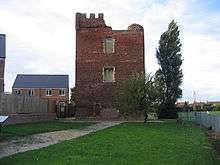 |
[270] | |
| Kyme Tower | Castle | 14th century | Fragment |  |
Private | [271] |
| Lincoln Castle | Keep and bailey | 11–13th century | Substantially intact |  |
Local Authority |
Double motte and bailey.[272] |
| Rochford Tower | Fortified house | 15–16th century | Fragment |  |
Private | 2 miles east of Boston.[273] |
| Somerton Castle | Quadrangular castle | 1281–1305 | Fragment |  |
Private | Single tower survives, adjoining a 17th-century building.[274] |
| Tattershall Castle | Tower | 1430s | Intact |  |
Brick tower built for Ralph Cromwell, restored in 1911–25 by Lord Curzon.[275] | |
| Torksey Castle | Semi-fortified house | 16th century | Fragmentary ruins |  |
Private | Slighted during English Civil War.[276] |
Merseyside
Castles of which no traces remain include:[2]
| Name | Type | Date | Condition | Image | Ownership / Access | Notes |
|---|---|---|---|---|---|---|
| Brimstage Hall | Tower house | c. 1398 | Substantially intact |  |
Crafts centre | Tower incorporated in later building of 16th and 19th centuries.[277] |
| Leasowe Castle | Sham castle | 16–19th century | Intact |  |
Hotel | Built in 1593, extended in 1600–42 and the 19th century.[278] |
Norfolk
Castles of which only earthworks or vestiges remain include:[2]
† The surviving motte of Thetford Castle is one of the highest in England,[279] about 80 ft (24 m) high.[280]
| Name | Type | Date | Condition | Image | Ownership / Access | Notes |
|---|---|---|---|---|---|---|
| Baconsthorpe Castle | Fortified manor house | 15th century | Fragmentary ruins |  |
[281] | |
| Burgh Castle | Motte and bailey | 12th century | No visible remains |  |
Site of medieval motte and bailey castle within surviving walls of Roman fort of Saxon Shore.[282] | |
| Caister Castle | Quadrangular castle | 1432–46 | Fragmentary ruins |  |
Moated, largely brick, built by John Fastolf, a relatively intact 90 ft (27 m) tower remains.[283] | |
| Castle Acre Castle | Motte and bailey | 11–12th century | Fragmentary remains |  |
Extensive earthworks.[284] | |
| Castle Rising Castle | Keep | c. 1138 | Ruins | [285] | ||
| Claxton Castle | Castle | 14–15th century | Fragmentary ruins |  |
Private | [286] |
| Norwich Castle | Keep | c. 1095–1110 | Intact |  |
Prison during 18–19th centuries.[287] | |
| Oxburgh Hall | Fortified manor house | c. 1482 | Intact |  |
18th- and 19th-century additions.[288] | |
| Weeting Castle | Fortified manor house | 12th century | Fragmentary ruins |  |
[289] |
Northamptonshire
Castles of which little or no traces remain include:[2]
† Fotheringhay Castle was the scene of the trial and execution of Mary, Queen of Scots in 1587.[290]
| Name | Type | Date | Condition | Image | Ownership / Access | Notes |
|---|---|---|---|---|---|---|
| Astwell Castle | Fortified manor house | 15th century | Fragment |  |
Private, farm | Gatehouse survives alongside a 17th-century house.[291] |
| Barnwell Castle | Rectangular castle | c. 1266 | Ruins |  |
Private | [292] |
| Rockingham Castle | Motte and bailey | 13–19th century | Rebuilt |  |
13th century gatehouse survives, largely rebuilt in the 16th century, remodelled in 1660 and by Anthony Salvin in 19th century.[293] | |
| Thorpe Waterville Castle | Castle | 14th century | Fragment |  |
Private | Great hall with fine open roof survives, altered for use as a barn.[294] |
Northumberland
Castles of which little or nothing remains include:[2]
- Cornhill Castle
- Dally Castle
- Duddo Tower
- Elsdon Castle
- Ford Parson's Tower
- Great Tosson Tower
- Haggerston Castle
- Haltwhistle Castle
- Heiferlaw Tower
- Hepple Tower
- Hethpool Tower
- Howtel Tower
- Kyloe Tower
- Little Swinburne Tower
- Lowick Castle
- Nafferton Castle
- Overgrass Tower
- Ponteland Castle
- Simonburn Castle
- Staward Peel
- Tarset Castle
- Thornton Tower
- Twizell Castle
- Warden Castle
- Wark Castle
- Welton Hall
- West Lilburn Tower
- Widdrington Castle
| Name | Type | Date | Condition | Image | Ownership / Access | Notes |
|---|---|---|---|---|---|---|
| Alnham Vicars Pele | Pele tower | 14th century | Restored |  |
Private | [295] |
| Alnwick Castle | Keep and bailey | 12–14th century | Restored | 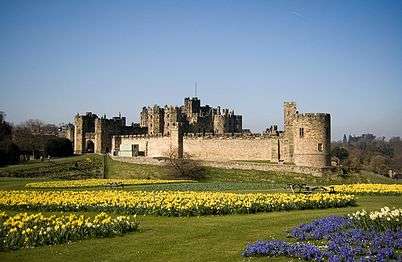 |
Duke of Northumberland |
Remodelled by Robert Adam and Anthony Salvin.[296] |
| Aydon Castle | Fortified manor house | 14th century | Intact |  |
Converted to farmhouse 17th century.[297] | |
| Bamburgh Castle | Keep and bailey | 12–14th century | Restored |  |
Lord Armstrong |
Ruinous by 1704, extensively restored in 1894–1904.[21] |
| Barmoor Castle | Tower house | 14–19th century | Rebuilt |  |
Private | 19th-century mansion incorporating remains of a 14th-century building.[298] |
| Beaufront Castle | Neo-romantic castle | 1836–1841 | Intact |  |
Private | 19th-century mansion on the site of a 15th-century tower house.[299] |
| Bellister Castle | Castle | 13–14th century | Fragmentary remains |  |
Private | Ruins adjoining a 17th-century house.[300] |
| Belsay Castle | Tower house | 1439–60 | Intact |  |
Later ruined building attached.[301] | |
| Berwick Castle | Castle | 12–13th century | Fragmentary remains |  |
[302] | |
| Bitchfield Castle | Pele tower | 14th century | Restored | Private | Incorporated in later mansion.[303] | |
| Blenkinsop Castle | Tower house | 14th century | Ruins | 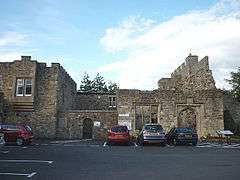 |
Private | Incorporated into a 19th-century house.[304] |
| Bothal Castle | Castle | 14th century | Rebuilt |  |
Private | Extensively restored in the 19th century.[305] |
| Bywell Castle | Castle | 15th century | Fragments |  |
Private | Gatehouse survives.[306] |
| Callaly Castle | Pele tower | 14–15th century | Intact | .jpg) |
Private apartments | Incorporated in later country house.[307] |
| Cartington Castle | Pele tower and extensions | 14–15th century | Fragmentary remains |  |
Private | [308] |
| Chillingham Castle | Quadrangular castle | 1344 | Intact |  |
Altered in the 17–19th centuries, restored after 1982.[309] | |
| Chipchase Castle | Tower house | 14th century | Intact |  |
Incorporated in Jacobean house, altered in the 18–19th centuries.[310] | |
| Cocklaw Tower | Tower house | 14–15th century | Shell |  |
Private, farm | Near Wall.[311] |
| Cockle Park Tower | Tower house | c. 1517 | Substantially intact |  |
Newcastle University | [312] |
| Corbridge Vicar's Pele | Pele tower | 1318 | Intact |  |
Re-roofed in 1910.[313] | |
| Coupland Castle | Tower house | 16–17th century | Restored |  |
Private | Later additions.[314] |
| Craster Tower | Pele tower | 14–15th century | Intact | Holiday accommodation | Incorporated in later building.[315] | |
| Crawley Tower | Pele tower | 14th century | Ruins |  |
Private | A cottage was built within the walls in the 18th century.[316] |
| Cresswell Castle | Pele tower | 15th century | Ruin |  |
18th century-parapet.[317] | |
| Dilston Castle | Tower house | 15th century | Ruins | 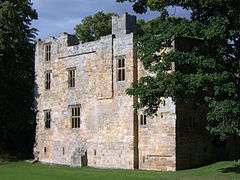 |
Altered in the 16–17th century, later buildings demolished.[318] | |
| Dunstanburgh Castle | Keep and bailey | 14th century | Fragmentary ruins |  |
Spectacular coastal setting.[319] | |
| Edlingham Castle | Keep and bailey | 14th century | Fragmentary ruins |  |
[320] | |
| Elsdon Tower | Pele tower | 16th century | Intact |  |
Private | Altered, rectory until 1960, restored in the 1990s.[321] |
| Embleton Tower | Pele tower | 14th century | Intact |  |
Private | 19th-century vicarage attached.[322] |
| Etal Castle | Castle | 14th century | Fragmentary ruins |  |
[323] | |
| Featherstone Castle | Castle | 14th century | Intact |  |
Private | 14th-century tower, three further towers added in the 18–19th century.[324] |
| Ford Castle | Quadrangular castle | 14th century | Substantially intact |  |
Private | Converted into mansion in the 17th century.[325] |
| Halton Castle | Tower house | 13–14th century | Intact |  |
Private | Attached to later house.[326] |
| Harbottle Castle | Keep and bailey | 12–14th century | Fragmentary ruins |  |
Northumberland National Park |
Captured by Robert Bruce in 1318.[327] |
| Haughton Castle | Tower house | 13–14th century | Restored |  |
Private | Altered in the 18–19th centuries.[328] |
| Hexham Moot Hall and Old Gaol | Fortified towers | 14–15th century | Intact | 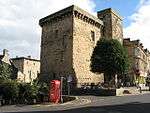 |
Probably once connected by bailey wall, AD1415 list of castles has "Turris de Hexham".[329][330] | |
| Horsley Tower, Longhorsley | Pele tower | 16th century | Intact |  |
Private | [331] |
| Langley Castle | Tower house | c. 1350 | Restored |  |
Hotel | Restored in the 1890s.[332] |
| Lemmington Hall | Tower house | 15th century | Restored |  |
Wedding venue | Incorporated in later house.[333] |
| Lindisfarne Castle | Artillery fort | 16th century | Restored |  |
Remodelled by Edwin Lutyens 1901.[334] | |
| Mitford Castle | Keep and bailey | 11–13th century | Fragmentary ruins |  |
[335] | |
| Morpeth Castle | Castle | 1342–9 | Fragments | 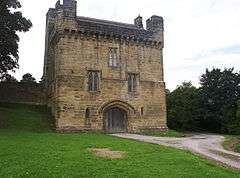 |
Landmark Trust | Only gatehouse and a section of wall remain.[336] |
| Norham Castle | Keep and bailey | 12th century | Ruins |  |
Keep remodelled in 1422–25, partly rebuilt in 1513–15.[337] | |
| Preston Tower, Ellingham | Pele tower | c. 1400 | Fragment |  |
South wall remains, with two of the original four turrets.[338] | |
| Prior Castell's Tower | Tower house | 15–16th century | Substantially intact |  |
[339] | |
| Prudhoe Castle | Castle | 12–14th century | Ruins |  |
[340] | |
| Shilbottle Tower | Pele tower | 15th century | Restored |  |
Private | Incorporated into a vicarage.[341] |
| Shortflatt Tower | Pele tower | 14–15th century | Restored | Wedding venue | Incorporated in later house.[342] | |
| Thirlwall Castle | Tower house | 14th century | Fragmentary ruins |  |
Northumberland National Park |
Built with stone from Hadrian's Wall.[343] |
| Warkworth Castle | Keep and bailey | 12–14th century | Ruins |  |
[344] | |
| Whittingham Tower | Pele tower | 13–14th century | Restored |  |
Private | Converted for use as almshouses in 1845.[345] |
| Whitton Tower | Pele tower | c. 1386 | Intact | Holiday accommodation | Near Rothbury, well-preserved.[346] | |
| Willimoteswick Castle | Fortified manor house | 16th century | Ruins |  |
Private, farm | Incorporates remains of earlier building, largely rebuilt in 1900.[347] |
North Yorkshire
Castles of which little remains include:[2]
- Acklam Motte
- Burton in Lonsdale Castle
- Buttercrambe Castle
- Carlton Castle
- Castle Levington
- Duffield Castle
- Guisborough Castle
- Harsley Castle
- Howe Hill (Yafforth)
- Hunmanby Castle
- Killerby Castle
- Kilton Castle
- Kirkby Fleetham Castle
- Kyme Castle
- Lythe Castle
- Malton Castle
- Saxton Castle
- Sigston Castle
- Slingsby Castle
- Tadcaster Castle
- Topcliffe Castle
- Upsall Castle
| Name | Type | Date | Condition | Image | Ownership / Access | Notes |
|---|---|---|---|---|---|---|
| Ayton Castle | Castle | 13–14th century | Fragment | Local authority |
[348] | |
| Barden Tower | Castle | 15th century | Ruins |  |
[349] | |
| Bolton Castle | Quadrangular castle | 14th century | Ruins | Besieged and slighted during English Civil War.[350] | ||
| Cawood Castle | Quadrangular castle | 1374–88 | Fragments |  |
Landmark Trust | Largely demolished in 1750, gatehouse survives.[351] |
| Clifford's Tower | Keep | 13th century | Restored | Reduced in height 1596.[352] | ||
| Crayke Castle | Tower house | 15th century | Restored |  |
Private | 18th- and 19th-century additions and alterations.[353] |
| Danby Castle | Quadrangular castle | 14th century | Fragmentary ruins |  |
Private, farm | Partly used as farm buildings.[354] |
| Gilling Castle | Tower house | 14th century | Intact | St. Martin's Ampleforth School | 16th- and 18th-century additions and alterations.[355] | |
| Hazlewood Castle | Castle | 13–18th century | Rebuilt |  |
Hotel | Altered in the 18th and 20th centuries, formerly Carmelite retreat centre.[356] |
| Hellifield Peel | Tower house | 14–15th century | Restored |  |
Hotel | Restored 2005.[357] |
| Helmsley Castle | Castle | 12–13th century | Fragmentary ruins |  |
Severely slighted in 1645.[358] | |
| Hornby Castle | Courtyard castle | 14–15th century | Restored |  |
Private | Converted to country house by John Carr, 18th century.[359] |
| Knaresborough Castle | Keep and bailey | 12–14th century | Fragmentary ruins | 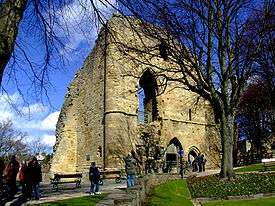 |
Duchy of Lancaster |
[360] |
| Marmion Tower | Fortified manor house | 15th century | Fragment |  |
Surviving gatehouse of Tanfield Castle.[361] | |
| Middleham Castle | Keep and bailey | 12–14th century | Ruins |  |
[362] | |
| (Old) Mulgrave Castle | Enclosure castle | 12–13th century | Fragmentary ruins |  |
Marquess of Normanby |
Superseded by 18–19th-century castellated mansion also known as Mulgrave Castle.[363] |
| Nappa Hall | Fortified manor house | 1459 | Intact |  |
Private | Enlarged in the 17th century, little altered since.[364] |
| Pickering Castle | Keep and bailey | 12–14th century | Ruins |  |
[365] | |
| Ravensworth Castle | Castle | 14th century | Fragmentary remains |  |
Private | [366] |
| Richmond Castle | Keep and bailey | 11–14th century | Ruins |  |
Keep 100 ft (30 m) high.[367] | |
| Ripley Castle | Tower house | 15–16th century | Rebuilt |  |
Extended in 1783–36 in Gothic Revival style.[368] | |
| Scarborough Castle | Keep and bailey | 12–13th century | Ruins |  |
[369] | |
| Sheriff Hutton Castle | Quadrangular castle | 1382 | Fragmentary ruins |  |
Private | [370] |
| Skelton Castle | Castellated house | 13–19th century | Intact |  |
Private | 18–19th-century house incorporates remains of medieval castle.[371] |
| Skipton Castle | Castle | 12–17th century | Restored |  |
Partly demolished in 1649, rebuilt in 1657–58.[372] | |
| Snape Castle | Castle | 15–18th century | Partly ruined | 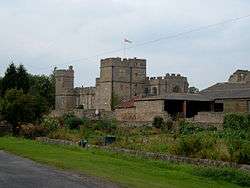 |
Private | Mostly reconstructed in the 17th century.[373] |
| South Cowton Castle | Tower house | 15th century | Restored |  |
Private | Altered in the 19th century, farmhouse.[374] |
| Spofforth Castle | Fortified manor house | 13–15th century | Fragmentary ruins |  |
[375] | |
| Whorlton Castle | Castle | 14–16th century | Fragmentary ruins |  |
Remains of gatehouse.[376] | |
| Wilton Castle | Neo-romantic castle | c. 1810 | Intact | Private apartments | By Smirke on site of medieval castle.[377] |
Nottinghamshire
Castles of which little remains include:[2]
| Name | Type | Date | Condition | Image | Ownership / Access | Notes |
|---|---|---|---|---|---|---|
| Halloughton Manor House | Pele tower | 14th century | Intact |  |
Private | Attached to later building.[378] |
| Newark Castle | Castle | 12–14th century | Ruins | .jpg) |
Gatehouse, part of curtain wall and a tower remain.[379] | |
| Nottingham Castle | Keep and bailey | 12–13th century | Fragmentary remains |  |
Nottingham City Council |
Demolished in 1651, later mansion on site, a much-restored 14th-century gatehouse remains.[380] |
Oxfordshire
Castles of which little or nothing remains include:[2]
| Name | Type | Date | Condition | Image | Ownership / Access | Notes |
|---|---|---|---|---|---|---|
| Bampton Castle | Quadrangular castle | c. 1315 | Fragment |  |
Private | Parts of gatehouse and curtain wall survive in later house, Ham Court.[381] |
| Broughton Castle | Fortified manor house | 14–15th century | Intact |  |
Remodelled in the 15–18th centuries.[382] | |
| Hanwell Castle | Castellated house | 15–16th century | Fragment |  |
Private | Large surviving tower of unfortified building.[383] |
| Oxford Castle | Motte and bailey | 11–12th century | Fragment |  |
Hotel | Motte and the unusual, possibly Saxon, St. George's Tower.[384] |
| Rotherfield Greys Castle | Fortified manor house | 14th century | Fragment |  |
Towers and section of wall survive, close to Greys Court.[385] | |
| Shirburn Castle | Quadrangular castle | c. 1378 | Rebuilt |  |
Private | Originally stone, largely rebuilt in brick c. 1720, remodelled in the 19th century.[386] |
| Wallingford Castle | Motte and bailey | 11–13th century | Fragmentary remains |  |
Slighted in 1652, impressive earthworks remain.[387] |
Rutland
Castles of which little or nothing remains include:[2]
| Name | Type | Date | Condition | Image | Ownership / Access | Notes |
|---|---|---|---|---|---|---|
| Oakham Castle | Motte and bailey | 12–13th century | Fragment |  |
Aisled great hall built in 1180–1190 survives.[388] |
Shropshire
Castles of which only earthworks or vestiges remain include:[2]
- Apley Castle
- Belan Bank (Kinnerley)
- Bishop's Castle
- Bryn Amlwg Castle
- Buckhurst Castle
- Bucknell Castle
- Caus Castle
- Charlton Castle
- Cleobury Castle
- Clungunford Castle
- Colebatch Castle
- Corfham Castle
- Ellesmere Castle
- Fordhall castle
- Hodnet Castle
- Holdgate Castle
- Knockin Castle
- Lea Castle
- Little Ness Castle
- Middlehope Castle
- Minton Castle
- Myddle Castle
- Oswestry Castle
- Pulverbatch Castle
- Rushbury Castle
- Ruyton-XI-Towns Castle
- Shrawardine Castle
- Stapleton Castle
- Wem Castle
- Soulton Castle
- The Beacon (Bretchel)
- Tong Castle
- Tyrley Castle
- West Felton Castle
- Wilcott Castle
- Wollaston Castle
- Yockleton Castle
| Name | Type | Date | Condition | Image | Ownership / Access | Notes |
|---|---|---|---|---|---|---|
| Acton Burnell Castle | Fortified manor house | 13th century | Ruins |  |
Shell, used as a barn in the 18th century.[389] | |
| Alberbury Castle | Castle | 13th century | Fragmentary remains |  |
[390] | |
| Bridgnorth Castle | Keep and bailey | 12th century | Fragmentary remains | Slighted in 1645.[391] | ||
| Broncroft Castle | Fortified manor house | 14th century | Intact |  |
Private | Renovated in the 19th century.[392] |
| Cheney Longville Castle | Fortified manor house | 14–17th century | Part habitable |  |
Private | Building At Risk.[393] |
| Clun Castle | Keep and bailey | 13th century | Fragmentary remains |  |
Ruins of keep built onto side of motte.[394] | |
| Hopton Castle | Keep and bailey | 14th century | Ruins |  |
[395] | |
| Ludlow Castle | Keep and bailey | 11–14th century | Ruins |  |
Earl of Powis |
One of the great Welsh border castles.[396] |
| Moreton Corbet Castle | Keep | 12th century | Fragmentary remains |  |
Adjoining ruins of a 16th-century building.[397] | |
| Quatford Castle | Neo-romantic castle | c. 1830 | Intact |  |
Private | Nearby are earthwork remains of the medieval Quatford Castle.[398] |
| Red Castle | Castle | 13th century | Fragmentary remains. | Overgrown, feature of Hawkstone Park landscape garden. Building At Risk.[399] | ||
| Rowton Castle | Sham castle | 18–19th century | Intact |  |
Hotel | On site of medieval castle, remodelled in 1809–12 by George Wyatt.[400] |
| Shrewsbury Castle | Castle | 12th century | Rebuilt | Shropshire Council |
Restored and extended in 1642, altered c. 1790 by Telford.[401] | |
| Stokesay Castle | Fortified manor house | 13–14th century | Intact |  |
Restored in the 19th century.[402] | |
| Wattlesborough Castle | Castle | 13–14th century | Fragment | 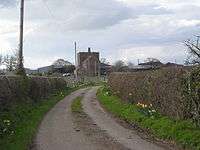 |
Private | Near Rowton, keep/tower survives, adjoining Wattlesborough Hall.[403] |
| Whittington Castle | Keep and bailey | 12–13th century | Fragments |  |
Local community |
Gatehouse towers survive.[404] |
Somerset
Castles of which only earthworks or no traces remain include:[2]
| Name | Type | Date | Condition | Image | Ownership / Access | Notes |
|---|---|---|---|---|---|---|
| Banwell Castle | Neo-romantic castle | c. 1848 | Intact |  |
Restaurant | Architect not known.[405] |
| Beckington Castle | 17th century | Rebuilt |  |
Company HQ | Medieval remains incorporated in later building.[406] | |
| Dunster Castle | Castle | 13–19th century | Rebuilt | 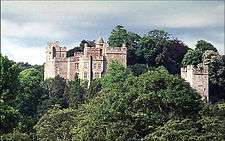 |
Existing house dates largely from c. 1571, with 18–19th-century alterations.[407] | |
| Farleigh Hungerford Castle | Enclosure castle | 14–15th century | Ruins | On high ground above the River Frome.[408] | ||
| Newton St Loe Castle | Fortified manor house | 14th century | Fragment |  |
Bath Spa University | Large tower and gatehouse, altered in the 16–17th century.[409] |
| Nunney Castle | Quadrangular castle | 1373 | Ruins |  |
Towers originally had conical roofs, north wall collapsed in 1910.[410] | |
| Stogursey Castle | Motte and bailey | 11–12th century | Fragmentary remains |  |
Landmark Trust | 17th-century house built within the remains of the castle.[411] |
| Sutton Court | Fortified manor house | 14–15th century | Fragment | Private apartments | Short length of embattled wall and a tower survive, incorporated in large house, restored in the 19th century.[412] | |
| Taunton Castle | Shell keep | 13th century | Restored | Now houses the Museum of Somerset, Castle Hotel incorporates remains of an outer gatehouse.[413] | ||
| Walton Castle | Sham castle | 1615–20 | Restored |  |
Private | Restored as private house 20th century.[414] |
| Wells Bishop's Palace | Fortified palace | 13–15th century | Substantially intact |  |
Church of England |
Adjacent to cathedral, residence of the Bishop of Bath and Wells.[415] |
South Yorkshire
Castles of which only earthworks, fragments or nothing remains include:[2]
| Name | Type | Date | Condition | Image | Ownership / Access | Notes |
|---|---|---|---|---|---|---|
| Conisbrough Castle | Keep and bailey | 12th century | Ruins |  |
Cylindrical keep, castle ruinous before English Civil War, so escaped slighting.[416] | |
| Tickhill Castle | Motte and bailey | 11–14th century | Fragmentary remains | Duchy of Lancaster | Ruined gatehouse and parts of curtain walls remain.[417] |
Staffordshire
Castles of which little or nothing remains include:[2]
| Name | Type | Date | Condition | Image | Ownership / Access | Notes |
|---|---|---|---|---|---|---|
| Alton Castle | Castle | 12–13th century | Fragmentary remains |  |
Youth centre | Cliff-top position, site partly occupied by a 19th-century building.[418] |
| Caverswall Castle | Enclosure castle | c. 1275 | Substantially intact |  |
Private | Moated, walls and towers reduced in height, a 17th-century mansion built within.[419] |
| Chartley Castle | Motte and bailey | 11–13th century | Fragmentary remains |  |
Private | Altered in 13th century to form enclosure castle, abandoned by 1485.[420] |
| Eccleshall Castle | Castle | 14th century | Fragmentary remains |  |
Private | Remains partly incorporated into house of c. 1695, rebuilt in the 19th century.[421] |
| Stafford Castle | Motte and bailey | 11–12th century | Earthworks |  |
Medieval keep partly rebuilt in the 19th century, then partly demolished.[422] | |
| Stourton Castle | Castle | 14–15th century | Fragment |  |
Private | Remains incorporated in later buildings.[423] |
| Tamworth Castle | Shell keep | 11–13th century | Rebuilt |  |
Local authority |
Largely rebuilt in the 16–18th centuries.[424] |
| Tutbury Castle | Motte and bailey | 12–15th century | Fragmentary ruins |  |
Slighted in 1647–48, a 19th-century folly stands on the motte.[425] |
Suffolk
Castles of which only earthworks or no traces remain include:[2]
| Name | Type | Date | Condition | Image | Ownership / Access | Notes |
|---|---|---|---|---|---|---|
| Bungay Castle | Keep and bailey | 12–13th century | Fragmentary remains |  |
Abandoned c. 1365.[426] | |
| Clare Castle | Motte and bailey | 11th century | Fragmentary remains |  |
Motte 53 ft (16 m) high.[427] | |
| Eye Castle | Motte and bailey | 11th century | Fragmentary remains | 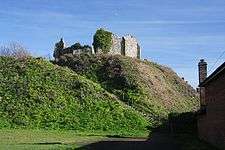 |
Motte over 40 ft (12 m) high.[428] | |
| Framlingham Castle | Enclosure castle | 12th century | Ruins |  |
Used as a poor house in the 17–19th centuries.[429] | |
| Mettingham Castle | Fortified manor house | c. 1342 | Fragmentary remains |  |
Private | Gatehouse survives.[430] |
| Orford Castle | Keep | 1165–73 | Intact | Unique polygonal keep survives.[431] | ||
| Wingfield Castle | Castle | c. 1385 | Fragment |  |
Private | South curtain wall, gatehouse and east drawbridge survive, with a 16–17th-century house.[432] |
Surrey
Castles of which only little or no traces remain include:[2]
| Name | Type | Date | Condition | Image | Ownership / Access | Notes |
|---|---|---|---|---|---|---|
| Farnham Castle | Keep and bailey | 12th century | Substantially intact | Shell keep replaced earlier keep part buried, part remodelled in the 17th century.[433] | ||
| Guildford Castle | Keep and bailey | 12–13th century | Ruins |  |
Local authority |
Tower keep survives, roofless since c. 17th century.[434] |
Tyne and Wear
Castles of which little remains include:[2]
| Name | Type | Date | Condition | Image | Ownership / Access | Notes |
|---|---|---|---|---|---|---|
| Hylton Castle | Tower house | c. 1400 | Ruins |  |
Large gatehouse tower, incorporated into an 18th-century house, since demolished.[435] | |
| Newcastle Castle | Keep and bailey | 1172–77 | Restored |  |
Keep and gatehouse survive.[436] | |
| Old Hollinside | Fortified manor house | 13th century | Ruins |  |
On slope overlooking River Derwent.[437] | |
| Ravensworth Castle | Quadrangular castle | 14–19th century | Ruins |  |
Private | Two towers of medieval castle survive, amidst ruins of later building. Building At Risk.[438] |
| Tynemouth Castle | Enclosure castle | 13–14th century | Ruins |  |
Built to enclose and protect the priory, modified as artillery castle 16th century.[439] |
Warwickshire
Castles of which only earthworks or vestiges remain include:[2]
| Name | Type | Date | Condition | Image | Ownership / Access | Notes |
|---|---|---|---|---|---|---|
| Astley Castle | Fortified manor house | 13–14th century | Shell |  |
Landmark Trust | Altered 15–19th centuries, hotel prior to fire in 1978. Modern living space constructed within shell, winner of Stirling Prize 2013.[440] |
| Kenilworth Castle | Keep and bailey | 12–14th century | Ruins | 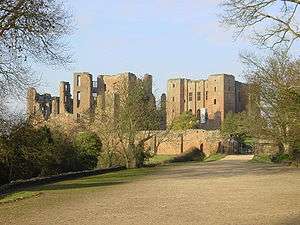 |
Altered in the 16th century, slighted in 1650.[441] | |
| Maxstoke Castle | Quadrangular castle | 14–15th century | Substantially intact |  |
NGS | Moated, domestic buildings of 15–19th centuries within curtain walls.[442] |
| Warwick Castle | Castle | 13–15th century | Intact |  |
Guy's tower rises 128 ft (39 m), 17th-century residential block, remodelled by Anthony Salvin after fire.[443] |
West Midlands
Castles of which little or no traces remain include:[2]
| Name | Type | Date | Condition | Image | Ownership / Access | Notes |
|---|---|---|---|---|---|---|
| Dudley Castle | Keep and bailey | 13–14th century | Ruins |  |
Dudley Zoo |
Slighted in 1647, then rebuilt and inhabited until destroyed by fire in 1750, partly restored in the 19th century.[444] |
West Sussex
Castles of which only little or no traces remain include:[2]
| Name | Type | Date | Condition | Image | Ownership / Access | Notes |
|---|---|---|---|---|---|---|
| Amberley Castle | Castle | 1377–82 | Partly habitable |  |
Hotel | Remodelled in the 16th century and later, incorporates a 12th-century manor, working portcullis.[445] |
| Arundel Castle | Keep and bailey | 12–13th century | Heavily restored |  |
Duke of Norfolk |
Remodelled in 1791–1815 and 1890–1903.[446] |
| Bramber Castle | Keep and bailey | 11–12th century | Fragmentary remains | 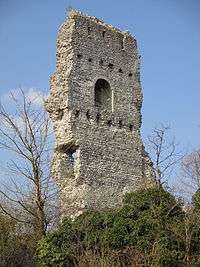 |
Commanding position, earthworks and fragment of wall remain.[447] | |
| Halnaker House | Fortified manor house | 13–14th century | Ruins |  |
Private | Altered in the 18th century, fell into ruin 1880s, replaced by later house of same name.[448] |
| (Old) Knepp Castle | Keep and motte | 1214 | Ruins |  |
Private | 11th century motte, with keep added in 1214. Mostly demolished in 1726.[449] |
West Yorkshire
Castles of which only earthworks or no traces remain include:[2]
| Name | Type | Date | Condition | Image | Ownership / Access | Notes |
|---|---|---|---|---|---|---|
| Dobroyd Castle | Sham Castle | 1866–9 | Intact |  |
Activity centre | By John Gibson.[450] |
| Harewood Castle | Tower house | 14th century | Ruins |  |
Private | Shell of tower, substantially intact, within Harewood House estate.[451] |
| Pontefract Castle | Enclosure castle | 12–13th century | Fragmentary remains |  |
Local authority |
Royal castle, withstood three sieges during English Civil War, afterwards dismantled.[452] |
| Sandal Castle | Motte and bailey | 12th century | Fragmentary remains |  |
Well-preserved earthworks, excavated site with visitor centre.[453] |
Wiltshire
Castles of which only little or no traces remain include:[2]
| Name | Type | Date | Condition | Image | Ownership / Access | Notes |
|---|---|---|---|---|---|---|
| Devizes Castle | Neo-romantic castle | 19th century | Intact | 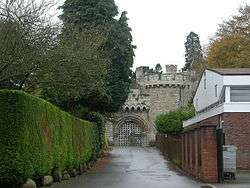 |
Private apartments | Present building begun 1842 on site of important medieval castle.[454] |
| Longford Castle | Sham castle | 1591 | Intact |  |
Earl of Radnor | Remodelled in the 18th century.[455] |
| Ludgershall Castle | Ringwork | 11–13th century | Fragmentary remains |  |
Remains of a tower and extensive earthworks.[456] | |
| Old Sarum Castle | Motte and bailey | 11–13th century | Fragmentary remains |  |
On site of Iron Age hill fort.[457] | |
| Old Wardour Castle | Castle | c. 1393 | Ruins |  |
Remodelled in the 16–17th centuries, superseded by Palladian building known as New Wardour Castle.[458] |
Worcestershire
Castles of which only earthworks remain include:[2]
| Name | Type | Date | Condition | Image | Ownership / Access | Notes |
|---|---|---|---|---|---|---|
| Caldwall Castle | Fortified manor house | 15–16th century | Fragment |  |
Private | Single surviving tower, in Kidderminster, Caldwall or Caldwell.[459] |
| Hartlebury Castle | Fortified manor house | 15th century | Rebuilt |  |
Church of England |
15th-century remains incorporated in later buildings, residence of Bishop of Worcester until 2007, houses Worcestershire County Museum.[460] |
| Holt Castle | Castle | 14–19th century | Intact |  |
Wedding venue | Medieval tower incorporated in later buildings.[461] |
| Worcester Castle | Castle | 13–14th century | Fragment |  |
Church of England | Edgar Tower, now the entrance to College Green, may incorporate the remains of a castle gatehouse.[462] |
See also
- British military history
- Castles in Great Britain and Ireland
- Castles in Northern Ireland
- Castles in Scotland
- Castles in the Isle of Man
- Castles in Wales
- List of castles
References
- Key to sources
- BLB – British Listed Buildings website (retrieved March 2011; last accessed 5 October 2012)
- PSC – Pastscape website (retrieved September 2011; last accessed 5 October 2012)
- ↑ Brown (1962), p.16.
- 1 2 3 4 5 6 7 8 9 10 11 12 13 14 15 16 17 18 19 20 21 22 23 24 25 26 27 28 29 30 31 32 33 34 35 36 37 38 39 40 41 42 43 44 45 46 47 48 49 King (1983).
- ↑ Brown (1962), p.24.
- ↑ Brown (1962), p.43.
- ↑ Brown (1962), p.50.
- ↑ Brown (1962), p.84
- ↑ Higham & Barker (1992), pp.194–198.
- ↑ Brown (1962), p.95.
- ↑ Brown (1962), p.221.
- ↑ Brown (1962), p.129.
- ↑ Brown (1962), p.131.
- ↑ Brown (1962), p.172.
- ↑ Brown (1962), p.15.
- ↑ Elton (1991), p.154.
- ↑ Harrington (2007), p.8.
- ↑ Brown (1962), p.128.
- ↑ Harrington (2007), p.2.
- 1 2 "Pendennis Castle" PSC.
- 1 2 Brown (1962), p.146.
- ↑ Creighton & Higham (2003), p.64.
- 1 2 "Bamburgh Castle" PSC.
- 1 2 3 "Belvoir Castle" PSC.
- ↑ Thompson (1987), pp.161–163.
- ↑ Impey & Parnell (2000), pp.118–121.
- 1 2 "Peckforton Castle" BLB.
- ↑ Renn (1984) pp.277–278. See King (1988), p.173 for how some people criticised the inclusion of Henry VIII's artillery forts in King's index of castles, Castellarium Anglicanum.
- 1 2 Pastscape
- 1 2 "Portchester Castle" PSC.
- 1 2 3 Gatehouse
- ↑ "Greystoke Castle " PSC.
- 1 2 "Thurland Castle" PSC.
- 1 2 3 British Listed Buildings
- 1 2 "Corby Castle " PSC.
- ↑ "Bedford Castle" PSC.
- ↑ "Someries Castle" PSC.
- ↑ "Donnington Castle" PSC.
- ↑ "Windsor Castle" BLB.
- ↑ "Boarstall Tower" PSC.
- ↑ "Buckden Palace" PSC.
- ↑ "Elton Hall" PSC.
- ↑ "Kimbolton Castle" PSC.
- ↑ "Kirtling Tower" PSC.
- ↑ "Longthorpe Tower" PSC.
- ↑ "Northborough Castle" PSC.
- ↑ "Woodcroft Castle" PSC.
- ↑ "Beeston Castle" PSC.
- ↑ "Chester Castle" PSC.
- ↑ "Cholmondeley Castle" BLB.
- ↑ "Delves Hall" PSC.
- ↑ "Halton Castle" PSC.
- ↑ "Auckland Castle" PSC.
- ↑ "Barnard Castle" PSC.
- ↑ "Bowes Castle" PSC.
- ↑ "Brancepeth Castle" PSC.
- ↑ "Durham Castle" PSC.
- ↑ "Lambton Castle" PSC.
- ↑ "Lumley Castle" PSC.
- ↑ "Mortham Tower" PSC.
- ↑ "Raby Castle" PSC.
- ↑ "Lambton Castle" PSC.
- ↑ "Scargill Castle" PSC.
- ↑ "Walworth Castle" PSC.
- ↑ "Witton Castle" PSC.
- ↑ "Caerhays Castle" PSC.
- ↑ "Carn Brea Castle" PSC.
- ↑ "Ince Castle" PSC.
- ↑ "Launceston Castle" PSC.
- ↑ "Pengersick Castle" PSC.
- ↑ "Place House" PSC.
- ↑ "Restormel Castle" PSC.
- ↑ "St. Catherine's Castle" PSC.
- ↑ "St. Mawes Castle" PSC.
- ↑ "St. Michael's Mount" PSC.
- ↑ "Tintagel Castle" PSC.
- ↑ "Trematon Castle" PSC.
- ↑ "Appleby Castle" PSC.
- ↑ "Armathwaite Castle" PSC.
- ↑ "Arnside Tower" PSC.
- ↑ "Askerton Castle" PSC.
- ↑ "Beetham Hall" PSC.
- ↑ "Bewcastle Castle" PSC.
- ↑ "Bewley Castle" PSC.
- ↑ "Blencow Hall" PSC.
- ↑ "Brackenburgh Old Tower" PSC.
- ↑ "Brackenhill Tower" PSC.
- ↑ "Branthwaite Hall" PSC.
- ↑ "Brough Castle" PSC.
- ↑ "Brougham Castle" PSC.
- ↑ "Brougham Hall" PSC.
- ↑ "Broughton Tower" PSC.
- ↑ "Burneside Hall" PSC.
- ↑ "Carlisle Castle" PSC.
- ↑ "Catterlen Hall" PSC.
- ↑ "Clifton Hall" PSC.
- ↑ "Cockermouth Castle" PSC.
- ↑ "Dacre Castle" PSC.
- ↑ "Dalston Hall" PSC.
- ↑ "Dalton Castle" PSC.
- ↑ "Drawdykes Castle" PSC.
- ↑ "Drumburgh Castle" PSC.
- ↑ "Gleaston Castle" PSC.
- ↑ "Greystoke Castle" PSC.
- ↑ "Harbybrow Tower" PSC.
- ↑ "Hayton Castle" PSC.
- ↑ "Hazelslack Tower" PSC.
- ↑ "Howgill Castle" PSC.
- ↑ "Hutton-in-the-Forest" PSC.
- ↑ "Hutton John" PSC.
- ↑ "Ingmire Hall" PSC.
- ↑ "Isel Hall" PSC.
- ↑ "Kendal Castle" PSC.
- ↑ "Kentmere Hall" PSC.
- ↑ "Kirkandrews Tower" PSC.
- ↑ "Linstock Castle" PSC.
- ↑ "Lowther Castle" PSC.
- ↑ "Middleton Hall" PSC.
- ↑ "Millom Castle" PSC.
- ↑ "Muncaster Castle" PSC.
- ↑ "Naworth Castle" PSC.
- ↑ "Newbiggin Hall" PSC.
- ↑ "Pendragon Castle" PSC.
- ↑ "Penrith Castle" PSC.
- ↑ "Piel Castle" PSC.
- ↑ "Prior's Tower" PSC.
- ↑ "Rose Castle" PSC.
- ↑ "Scaleby Castle" PSC.
- ↑ "Sizergh Castle" PSC.
- ↑ "Toppin Castle" BLB.
- ↑ "Ubarrow Hall" PSC.
- ↑ "Wharton Hall" PSC.
- ↑ "Whitehall, Allhallows" BLB.
- ↑ Emery (1996), p.256.
- ↑ "Workington Hall" PSC.
- ↑ "Wray Castle" PSC.
- ↑ "Wraysholme Tower" PSC.
- ↑ "Yanwath Hall" PSC.
- ↑ "Bolsover Castle" PSC.
- ↑ "Codnor Castle" PSC.
- ↑ "Elvaston Castle" PSC.
- ↑ "Haddon Hall" PSC.
- ↑ "Mackworth Castle" PSC.
- ↑ "Peveril Castle" PSC.
- ↑ "Riber Castle" BLB.
- ↑ "Wingfield Manor" PSC.
- ↑ "Affeton Castle" BLB.
- ↑ "Berry Pomeroy Castle" PSC.
- ↑ "Bickleigh Castle" PSC.
- ↑ "Compton Castle" PSC.
- ↑ "Dartmouth Castle" PSC.
- ↑ "Castle Drogo" PSC.
- ↑ "Gidleigh Castle" PSC.
- ↑ "Hemyock Castle" PSC.
- ↑ "Kingswear Castle" PSC.
- ↑ "Lydford Castle" PSC.
- ↑ "Marisco Castle" PSC.
- ↑ "Okehampton Castle" PSC.
- ↑ "Plympton Castle" PSC.
- ↑ "Powderham Castle" PSC.
- ↑ "Rougemont Castle" PSC.
- ↑ "Salcombe Castle" PSC.
- ↑ "Tiverton Castle" PSC.
- ↑ "Totnes Castle" PSC.
- ↑ "Watermouth Castle" PSC.
- ↑ "Brownsea Castle" PSC.
- ↑ "Christchurch Castle" PSC.
- ↑ "Corfe Castle" PSC.
- ↑ "Lulworth Castle" PSC.
- ↑ "Pennsylvania Castle" PSC.
- ↑ "Portland Castle" PSC.
- ↑ "Rufus Castle" PSC.
- ↑ "Sherborne Old Castle" PSC.
- ↑ "Woodsford Castle" PSC.
- ↑ "Paull Holme Tower" PSC.
- ↑ "Skipsea Castle" PSC.
- ↑ "Wressle Castle" PSC.
- ↑ "Bodiam Castle" PSC.
- ↑ "Camber Castle" PSC.
- ↑ "Hastings Castle" PSC.
- ↑ "Herstmonceux Castle" PSC.
- ↑ "Lewes Castle" PSC.
- ↑ "Pevensey Castle" PSC.
- ↑ "Ypres Tower" PSC.
- ↑ "Pleshey Castle" PSC.
- ↑ "Colchester Castle" PSC.
- ↑ "Hadleigh Castle" PSC.
- ↑ "Hedingham Castle" PSC.
- ↑ "Walden Castle" PSC.
- ↑ "Berkeley Castle" PSC.
- ↑ "Beverstone Castle" PSC.
- ↑ "St. Briavel's Castle" PSC.
- ↑ "Sudeley Castle" PSC.
- ↑ "Thornbury Castle" PSC.
- ↑ "White Tower" PSC.
- ↑ "Radcliffe Tower" PSC.
- ↑ "Calshot Castle" PSC.
- ↑ "Hurst Castle" PSC.
- ↑ "Netley Castle" PSC.
- ↑ "Odiham Castle" PSC.
- ↑ "Southampton Castle" PSC.
- ↑ "Southsea Castle" PSC.
- ↑ "Winchester Castle" PSC.
- ↑ "Wolvesey Castle" PSC.
- ↑ "Ewyas Harold Castle" PSC.
- ↑ "Brampton Bryan Castle" PSC.
- ↑ "Clifford Castle" PSC.
- ↑ "Croft Castle" PSC.
- ↑ "Downton Castle" BLB.
- ↑ "Eastnor Castle" PSC.
- ↑ "Goodrich Castle" PSC.
- ↑ "Hampton Court" PSC.
- ↑ "Kentchurch Court" PSC.
- ↑ "Kinnersley Castle" PSC.
- ↑ "Longtown Castle" PSC.
- ↑ "Pembridge Castle" PSC.
- ↑ "Snodhill Castle" PSC.
- ↑ "Treago Castle" PSC.
- ↑ "Wigmore Castle" PSC.
- ↑ "Wilton Castle" PSC.
- ↑ "Defending the Castle". Retrieved 10 February 2015.
- ↑ "Berkhamsted Castle" PSC.
- ↑ "Hertford Castle" PSC.
- ↑ "Carisbrooke Castle" PSC.
- ↑ "Norris Castle" PSC.
- ↑ "Yarmouth Castle" PSC.
- ↑ "West Cowes Castle" PSC.
- ↑ "Cromwell's Castle" PSC.
- ↑ "Star Castle" PSC.
- ↑ "Allington Castle" PSC.
- ↑ "Canterbury Castle" PSC.
- ↑ "Chiddingstone Castle" PSC.
- ↑ "Chilham Castle" PSC.
- ↑ "Cooling Castle" PSC.
- ↑ "Deal Castle" PSC.
- ↑ "Dover Castle" PSC.
- ↑ "Eynsford Castle" PSC.
- ↑ "Hever Castle" PSC.
- ↑ "Kingsgate Castle" BLB.
- ↑ "Leeds Castle" PSC.
- ↑ "Leybourne Castle" PSC.
- ↑ "Lullingstone Castle" PSC.
- ↑ "Lympne Castle" PSC.
- ↑ "Otford Palace 1" "Otford Palace 2" BLB.
- ↑ "Penshurst Place" BLB.
- ↑ Brown (1962), p.69.
- ↑ "Rochester Castle" PSC.
- ↑ "St. Leonard's Tower" PSC.
- ↑ "Saltwood Castle" PSC.
- ↑ "Sandgate Castle" PSC.
- ↑ "Scotney Castle" PSC.
- ↑ "Sissinghurst Castle" PSC.
- ↑ "Starkey Castle" BLB.
- ↑ "Stone Castle" PSC.
- ↑ "Sutton Valence Castle" PSC.
- ↑ "Tonbridge Castle" PSC.
- ↑ "Upnor Castle" PSC.
- ↑ "Walmer Castle" PSC.
- ↑ "Westenhanger Castle" PSC.
- ↑ "Ashton Hall" PSC.
- ↑ "Borwick Hall" PSC.
- ↑ "Clitheroe Castle" PSC.
- ↑ "Hornby Castle" PSC.
- ↑ "Lancaster Castle" PSC.
- ↑ "Turton Tower" PSC.
- ↑ "Ashby de la Zouch Castle" PSC.
- ↑ "Kirby Muxloe Castle" PSC.
- ↑ "Leicester Castle" PSC.
- ↑ "Goltho Castle" PSC.
- ↑ "Bolingbroke Castle" PSC.
- ↑ "Grimsthorpe Castle" PSC.
- ↑ "Hussey Tower" PSC.
- ↑ "Kyme Tower" PSC.
- ↑ "Lincoln Castle" PSC.
- ↑ "Rochford Tower" PSC.
- ↑ "Somerton Castle" PSC.
- ↑ "Tattershall Castle" PSC.
- ↑ "Torksey Castle" PSC.
- ↑ "Brimstage Hall" PSC.
- ↑ "Leasowe Castle" PSC.
- ↑ Brown (1962), p.59.
- ↑ "Thetford Castle" PSC.
- ↑ "Baconsthorpe Castle" PSC.
- ↑ "Burgh Castle" PSC.
- ↑ "Caister Castle" PSC.
- ↑ "Castle Acre Castle" PSC.
- ↑ "Castle Rising Castle" PSC.
- ↑ "Claxton Castle" PSC.
- ↑ "Norwich Castle" PSC.
- ↑ "Oxburgh Hall" PSC.
- ↑ "Weeting Castle" PSC.
- ↑ "Fotheringhay Castle" PSC.
- ↑ "Astwell Castle" PSC.
- ↑ "Barnwell Castle" PSC.
- ↑ "Rockingham Castle" PSC.
- ↑ "Thorpe Waterville Castle" PSC.
- ↑ "Alnham Vicars Pele" PSC.
- ↑ "Alnwick Castle" PSC.
- ↑ "Aydon Castle" PSC.
- ↑ "Barmoor Castle" BLB.
- ↑ "Beaufront Castle" PSC.
- ↑ "Bellister Castle" PSC.
- ↑ "Belsay Castle" PSC.
- ↑ "Berwick Castle" PSC.
- ↑ "Bitchfield Castle" PSC.
- ↑ "Blenkinsop Castle" PSC.
- ↑ "Bothal Castle" PSC.
- ↑ "Bywell Castle" PSC.
- ↑ "Callaly Castle" PSC.
- ↑ "Cartington Castle" PSC.
- ↑ "Chillingham Castle" PSC.
- ↑ "Chipchase Castle" PSC.
- ↑ "Cocklaw Tower" PSC.
- ↑ "Cockle Park Tower" PSC.
- ↑ "Corbridge Vicar's Pele" PSC.
- ↑ "Coupland Castle" PSC.
- ↑ "Craster Tower" PSC.
- ↑ "Crawley Tower" PSC.
- ↑ "Cresswell Castle" PSC.
- ↑ "Dilston Castle" PSC.
- ↑ "Dunstanburgh Castle" PSC.
- ↑ "Edlingham Castle" PSC.
- ↑ "Elsdon Tower" PSC.
- ↑ "Embleton Tower" PSC.
- ↑ "Etal Castle" PSC.
- ↑ "Featherstone Castle" PSC.
- ↑ "Ford Castle" PSC.
- ↑ "Halton Castle" PSC.
- ↑ "Harbottle Castle" PSC.
- ↑ "Haughton Castle" PSC.
- ↑ "Hexham Moot Hall" PSC.
- ↑ "Hexham Old Gaol" PSC.
- ↑ "Horsley Tower" PSC.
- ↑ "Langley Castle" PSC.
- ↑ "Lemmington Hall" PSC.
- ↑ "Lindisfarne Castle" PSC.
- ↑ "Mitford Castle" PSC.
- ↑ "Morpeth Castle" PSC.
- ↑ "Norham Castle" PSC.
- ↑ "Preston Tower" PSC.
- ↑ "Prior Castell's Tower" PSC.
- ↑ "Prudhoe Castle" PSC.
- ↑ "Shilbottle Tower" PSC.
- ↑ "Shortflatt Tower" PSC.
- ↑ "Thirlwall Castle" PSC.
- ↑ "Warkworth Castle" PSC.
- ↑ "Whittingham Tower" PSC.
- ↑ "Whitton Tower" PSC.
- ↑ "Willimoteswick Castle" Gatehouse
- ↑ "Ayton Castle" PSC.
- ↑ "Barden Tower" PSC.
- ↑ "Bolton Castle" PSC.
- ↑ "Cawood Castle" PSC.
- ↑ "Clifford's Tower" PSC.
- ↑ "Crayke Castle" BLB.
- ↑ "Danby Castle" PSC.
- ↑ "Gilling Castle" PSC.
- ↑ "Hazlewood Castle" PSC.
- ↑ "Hellifield Peel" PSC.
- ↑ "Helmsley Castle" PSC.
- ↑ "Hornby Castle" PSC.
- ↑ "Knaresborough Castle" PSC.
- ↑ "Marmion Tower" PSC.
- ↑ "Middleham Castle" PSC.
- ↑ "Old Mulgrave Castle" PSC.
- ↑ "Nappa Hall" BLB.
- ↑ "Pickering Castle" PSC.
- ↑ "Ravensworth Castle" PSC.
- ↑ "Richmond Castle" PSC.
- ↑ "Ripley Castle" PSC.
- ↑ "Scarborough Castle" PSC.
- ↑ "Sheriff Hutton Castle" PSC.
- ↑ "Skelton Castle" BLB.
- ↑ "Skipton Castle" PSC.
- ↑ "Snape Castle" BLB.
- ↑ "South Cowton Castle" PSC.
- ↑ "Spofforth Castle" PSC.
- ↑ "Whorlton Castle" PSC.
- ↑ "Wilton Castle" BLB.
- ↑ "Halloughton Manor House" PSC.
- ↑ "Newark Castle" PSC.
- ↑ "Nottingham Castle" PSC.
- ↑ "Bampton Castle" PSC.
- ↑ "Broughton Castle" PSC.
- ↑ "Hanwell Castle" PSC.
- ↑ Blair (1998), p.137.
- ↑ "Greys Court" PSC.
- ↑ "Shirburn Castle" PSC.
- ↑ "Wallingford Castle" PSC.
- ↑ "Oakham Castle" PSC.
- ↑ "Acton Burnell Castle" PSC.
- ↑ "Alberbury Castle" PSC.
- ↑ "Bridgnorth Castle" PSC.
- ↑ "Broncroft Castle" PSC.
- ↑ "Cheney Longville Castle" PSC.
- ↑ "Clun Castle" PSC.
- ↑ "Hopton Castle" PSC.
- ↑ "Ludlow Castle" PSC.
- ↑ "Moreton Corbet Castle" PSC.
- ↑ "Quatford Castle" BLB.
- ↑ "Red Castle" PSC.
- ↑ "Rowton Castle" PSC.
- ↑ "Shrewsbury Castle" PSC.
- ↑ "Stokesay Castle" PSC.
- ↑ "Wattlesborough Castle" PSC.
- ↑ "Whittington Castle" PSC.
- ↑ "Banwell Castle" PSC.
- ↑ Buildings of England, Somerset: South & West (1958) ISBN 978-0-300-09644-6.
- ↑ "Dunster Castle" PSC.
- ↑ "Farleigh Hungerford Castle" PSC.
- ↑ "Newton St Loe" PSC.
- ↑ "Nunney Castle" PSC.
- ↑ "Stogursey Castle" PSC.
- ↑ "Sutton Court" PSC.
- ↑ "Taunton Castle" PSC.
- ↑ "Walton Castle" PSC.
- ↑ "Wells Bishop's Palace" BLB.
- ↑ "Conisbrough Castle" PSC.
- ↑ "Tickhill Castle" PSC.
- ↑ "Alton Castle" PSC.
- ↑ "Caverswall Castle" PSC.
- ↑ "Chartley Castle" PSC.
- ↑ "Eccleshall Castle" PSC.
- ↑ "Stafford Castle" PSC.
- ↑ "Stourton Castle" PSC.
- ↑ "Tamworth Castle" PSC.
- ↑ "Tutbury Castle" PSC.
- ↑ "Bungay Castle" PSC.
- ↑ "Clare Castle" PSC.
- ↑ "Eye Castle" PSC.
- ↑ "Framlingham Castle" PSC.
- ↑ "Mettingham Castle" PSC.
- ↑ "Orford Castle" PSC.
- ↑ "Wingfield Castle" PSC.
- ↑ "Farnham Castle" PSC.
- ↑ "Guildford Castle" PSC.
- ↑ "Hylton Castle" PSC.
- ↑ "Newcastle Castle" PSC.
- ↑ "Old Hollinside" PSC.
- ↑ "Ravensworth Castle" PSC.
- ↑ "Tynemouth Castle" PSC.
- ↑ "Astley Castle" PSC.
- ↑ "Kenilworth Castle" PSC.
- ↑ "Maxstoke Castle" PSC.
- ↑ "Warwick Castle" PSC.
- ↑ "Dudley Castle" PSC.
- ↑ "Amberley Castle" PSC.
- ↑ "Arundel Castle" PSC.
- ↑ "Bramber Castle" PSC.
- ↑ "Halnaker House" PSC.
- ↑ http://www.pastscape.org.uk/hob.aspx?hob_id=396696&sort=4&search=exact&criteria=Knepp%20Castle&rational=q&recordsperpage=10
- ↑ "Dobroyd Castle" PSC.
- ↑ "Harewood Castle" PSC.
- ↑ "Pontefract Castle" PSC.
- ↑ "Sandal Castle" PSC.
- ↑ "Devizes Castle" PSC.
- ↑ "Longford Castle" PSC.
- ↑ "Ludgershall Castle" PSC.
- ↑ "Old Sarum Castle" PSC.
- ↑ "Old Wardour Castle" PSC.
- ↑ "Caldwall Castle" PSC.
- ↑ "Hartlebury Castle" PSC.
- ↑ "Holt Castle" PSC.
- ↑ "Worcester Castle" PSC.
Bibliography
- Emery, A. (1996) Greater Medieval Houses of England and Wales, 1300-1500: Volume 1, Northern England Cambridge: Cambridge University Press. ISBN 978-0-521-49723-7
- Blair, J. (1998) Anglo-Saxon Oxfordshire London: Sutton. ISBN 978-0-7509-1750-6.
- Brown, R. Allen (1962) English Castles London: Batsford. ISBN 978-0-907486-06-0.
- Creighton, Oliver (2002) Castles and Landscapes London: Continuum. ISBN 978-0-8264-5896-4.
- Elton, G.R. (1991) England Under the Tudors London: Routledge. ISBN 978-0-415-06533-7.
- Harrington, P. (2007) The Castles of Henry VIII Oxford: Osprey. ISBN 978-1-84603-130-4.
- Higham, Robert; Barker, Philip (1992) Timber Castles London: Batsford. ISBN 978-0-7134-2189-7.
- Impey, Edward; Parnell, Geoffrey (2000) The Tower of London: The Official Illustrated History Merrell Publishers in association with Historic Royal Palaces. ISBN 978-1-85894-106-6.
- King, D.J. Cathcart (1983) Castellarium Anglicanum: An Index and Bibliography of the Castles in England, Wales and the Islands London: Kraus International Publications ISBN 978-0-527-50110-5.
- King, D.J. Cathcart (1988) The Castle in England and Wales: An Interpretative History London: Croom Helm. ISBN 978-0-918400-08-6.
- Renn, Derek (1984) "Review: Castellarium Anglicanum by D.J. Cathcart King" Medieval Archaeology 28: 277–278.
- Thompson, Michael (1987) The Decline of the Castle Cambridge: Cambridge University Press. ISBN 978-0-521-32194-5.
External links
- Castles of England and Wales
- CastleXplorer
- Castles in England A–Z
- CastleStories - Google Map Explorer
- Gatehouse - comprehensive gazetteer and bibliography of the castles of England and Wales
